SRI LANKA - Sigiriya
 Sigiriya, once the capital of Sri Lanka, was built during the 5th century by King Kashyapa. Lying on a granite peak of 200m above the surrounding plane, Sigiriya is a UNESCO World Heritage Site. Considered by some to be the eighth wonder of the ancient world, Sigiriya is the most visited historic site in Sri Lanka.
Sigiriya, once the capital of Sri Lanka, was built during the 5th century by King Kashyapa. Lying on a granite peak of 200m above the surrounding plane, Sigiriya is a UNESCO World Heritage Site. Considered by some to be the eighth wonder of the ancient world, Sigiriya is the most visited historic site in Sri Lanka.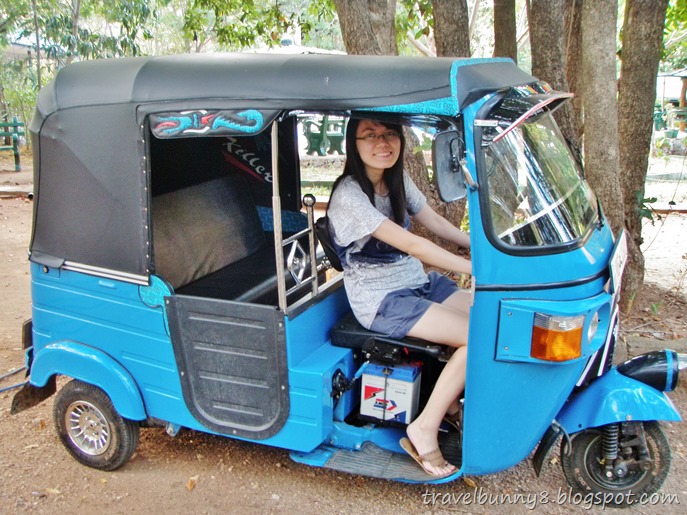 The three wheel automobile also known as Tuks-Tuks is the most common mode of transport in Sri Lanka. Come on and hop in, I’ll give you a ride.
The three wheel automobile also known as Tuks-Tuks is the most common mode of transport in Sri Lanka. Come on and hop in, I’ll give you a ride. 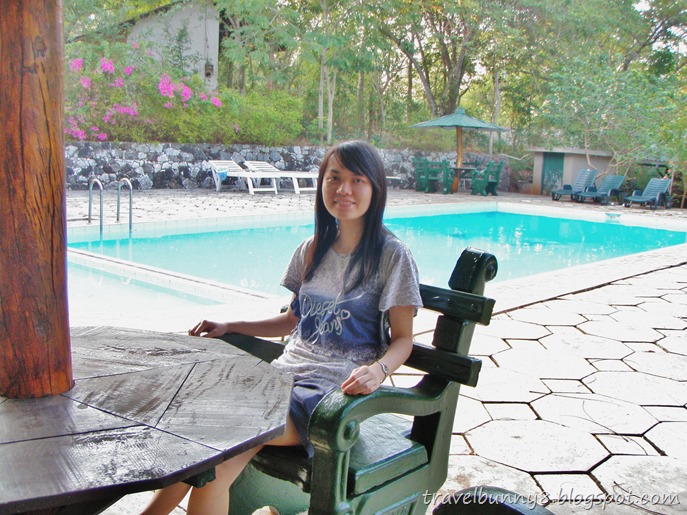 Having breakfast by the pool.
Having breakfast by the pool. 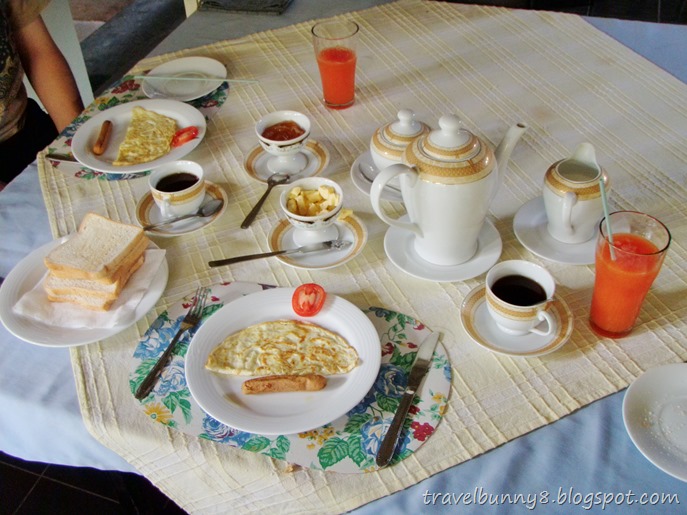 Had a nice breakfast before heading out.
Had a nice breakfast before heading out.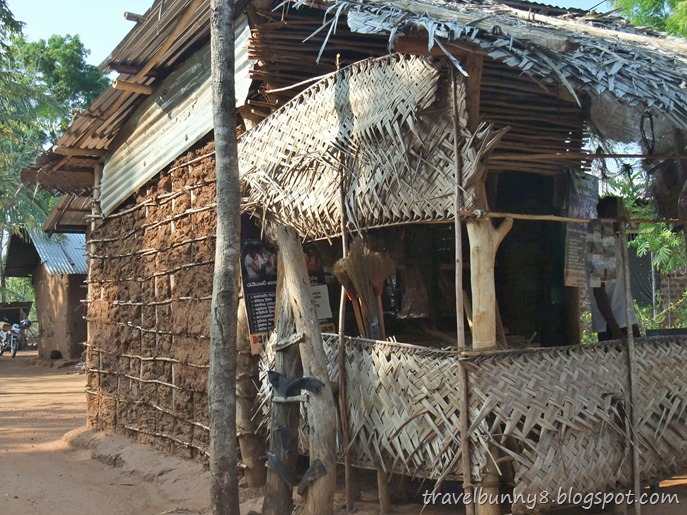 Passed by a row of ‘mud’ buildings.
Passed by a row of ‘mud’ buildings. 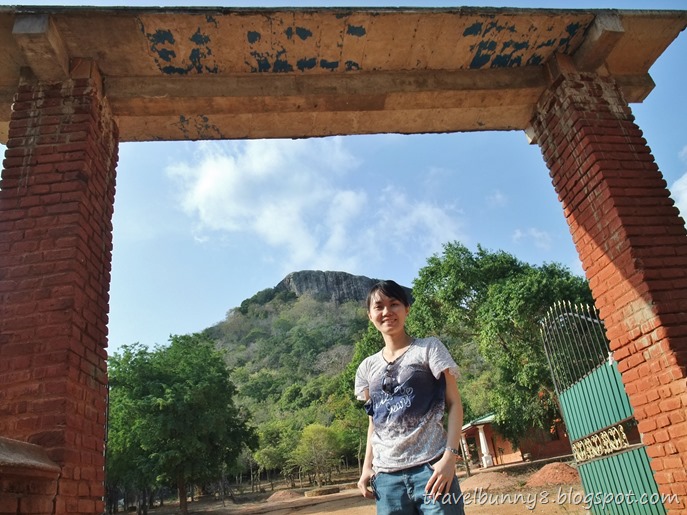 Stopped here at a small temple.
Stopped here at a small temple.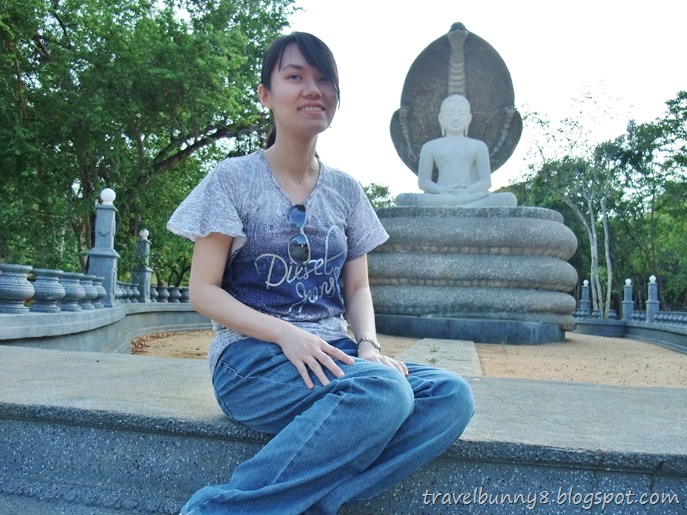 For some photographs.
For some photographs.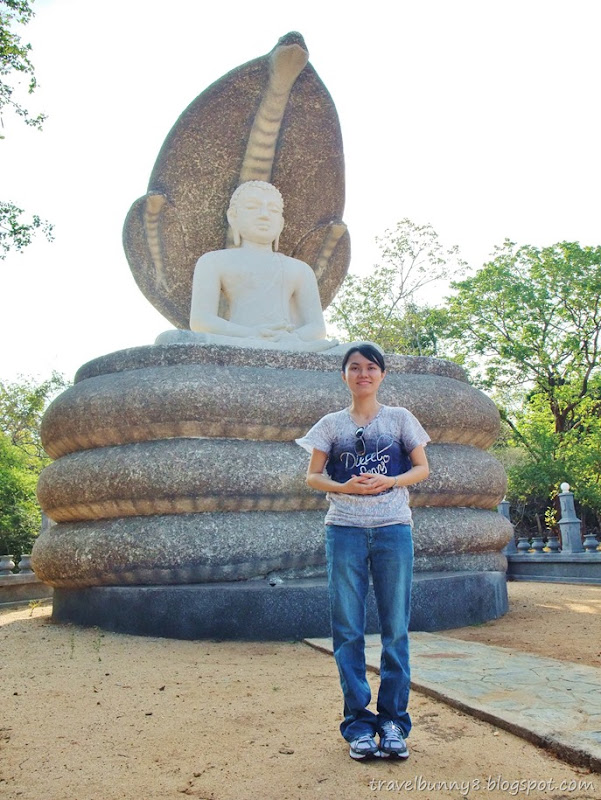 While Buddha was meditating at the foot of a tree, it began to rain heavily. A huge king cobra came out and coiled his body around Buddha to keep him warm and placed its hood over him to protect him from the rain.
While Buddha was meditating at the foot of a tree, it began to rain heavily. A huge king cobra came out and coiled his body around Buddha to keep him warm and placed its hood over him to protect him from the rain. 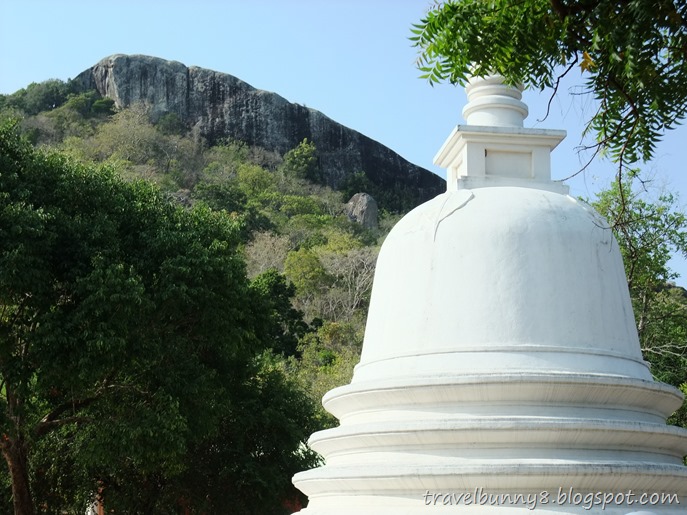 A stupa at the temple.
A stupa at the temple.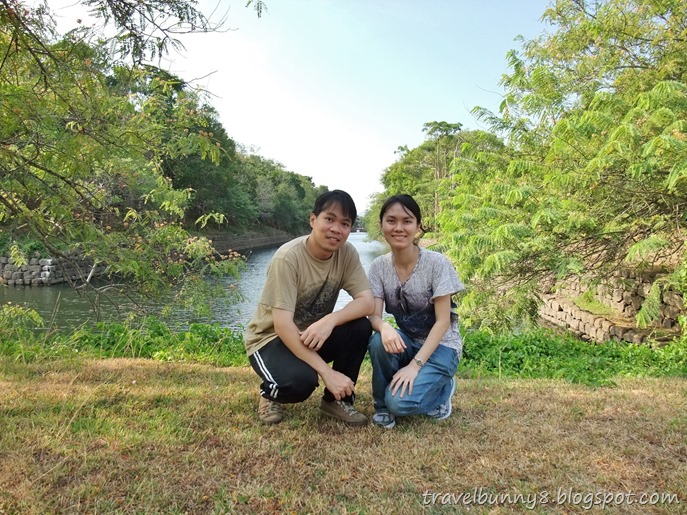 We are now at the moat that surrounds the lower palace of Sigiriya.
We are now at the moat that surrounds the lower palace of Sigiriya.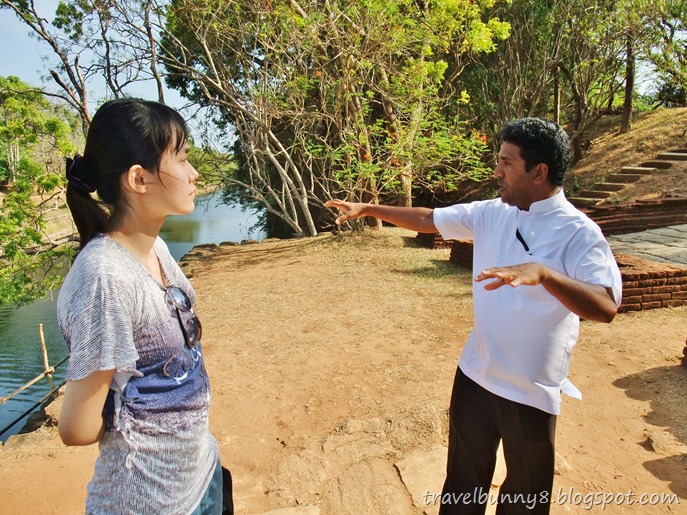 The Sigiriya guide informing us that the moat used to be filled with crocodiles.
The Sigiriya guide informing us that the moat used to be filled with crocodiles.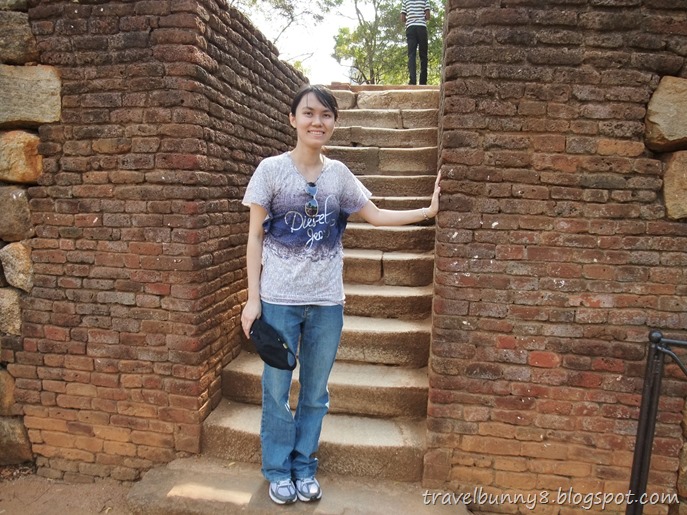 Let’s begin the tour of Sigiriya.
Let’s begin the tour of Sigiriya.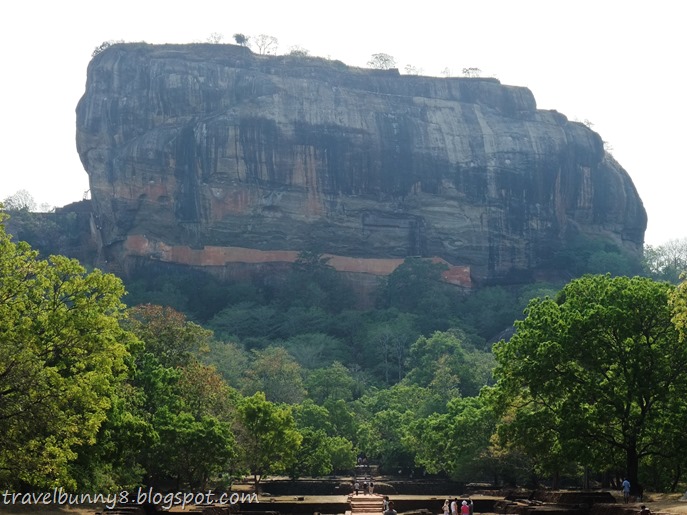 Rising 370m above sea level, Sigiriya is one of the largest monoliths in the world. Also known as the Lion Mountain, King Kashyapa I, built his palace on top of the Sigiriya rock. Because of the strategic advantage during an attack, whereby the rock offers a wide view in all directions, Sigiriya was chosen as the capital.
Rising 370m above sea level, Sigiriya is one of the largest monoliths in the world. Also known as the Lion Mountain, King Kashyapa I, built his palace on top of the Sigiriya rock. Because of the strategic advantage during an attack, whereby the rock offers a wide view in all directions, Sigiriya was chosen as the capital.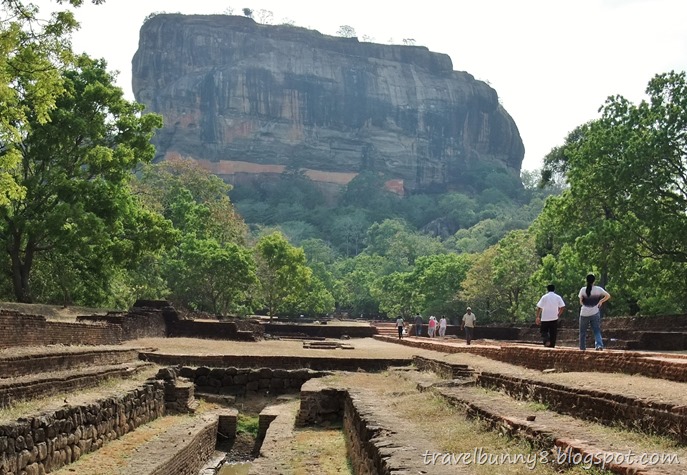 Sigiriya was a well planned royal city with a palace complex centred around a solitary rock adorned with pleasant and vibrant gardens. The water gardens is an astounding example of early hydraulics providing surface drainage, erosion control and recreational water features. The water supply for the fountains operated through gravity and pressure and they still work today.
Sigiriya was a well planned royal city with a palace complex centred around a solitary rock adorned with pleasant and vibrant gardens. The water gardens is an astounding example of early hydraulics providing surface drainage, erosion control and recreational water features. The water supply for the fountains operated through gravity and pressure and they still work today.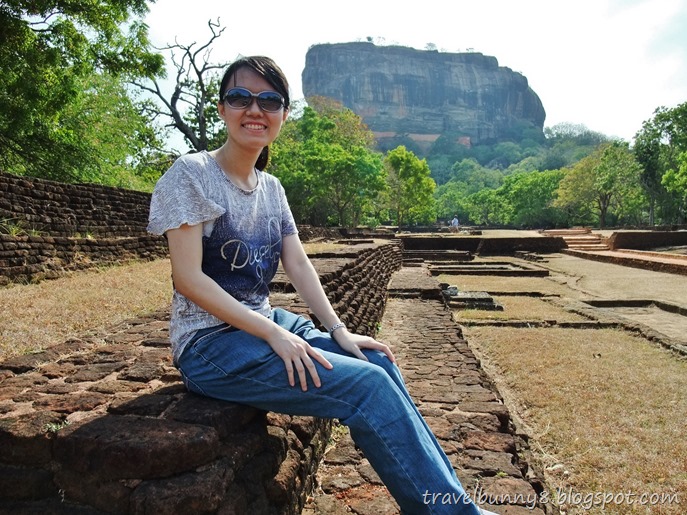 Sigiriya offers the best example of an ancient Asian city centre and an excellent example of advanced Sri Lankan urban planning, architecture, engineering, landscaping, sculpture and art.
Sigiriya offers the best example of an ancient Asian city centre and an excellent example of advanced Sri Lankan urban planning, architecture, engineering, landscaping, sculpture and art. 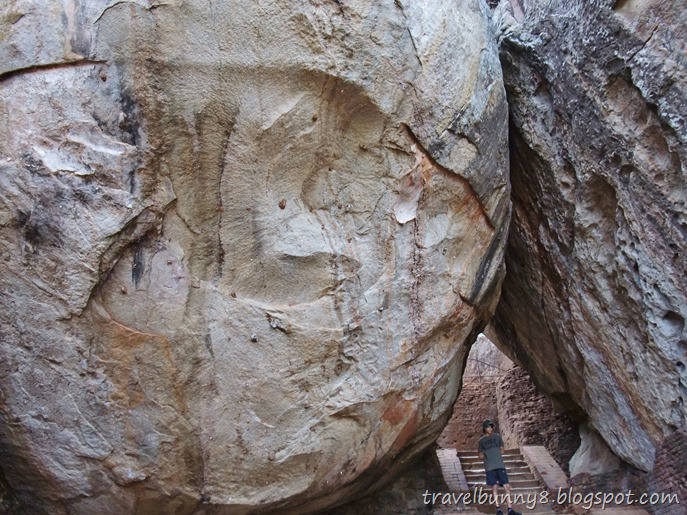 Two huge boulders at the Boulder Garden.
Two huge boulders at the Boulder Garden.  I’ve been told there is a total of 1,200 steps to climb before reaching the summit of the rock.
I’ve been told there is a total of 1,200 steps to climb before reaching the summit of the rock.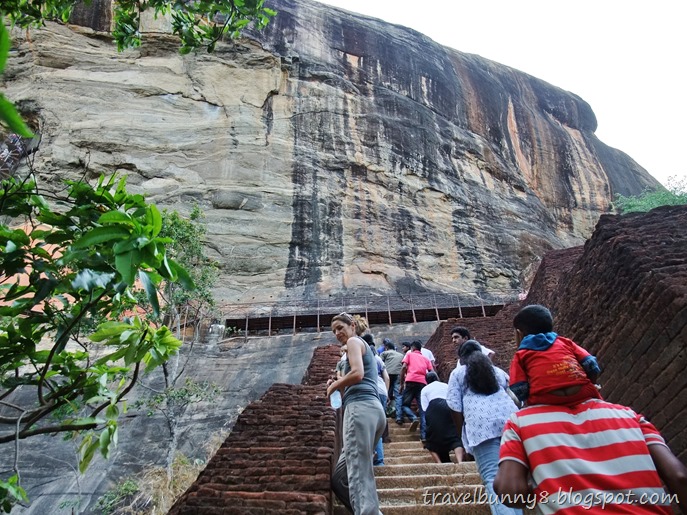 Sigiriya is a fortress with two moats, outer walls, middle walls and inner wall. Not satisfied with the defences, King Kashyapa I had to build his palace on top of a 200m high rock. He must be paranoid that someone might attack him. Well, he should be!
Sigiriya is a fortress with two moats, outer walls, middle walls and inner wall. Not satisfied with the defences, King Kashyapa I had to build his palace on top of a 200m high rock. He must be paranoid that someone might attack him. Well, he should be!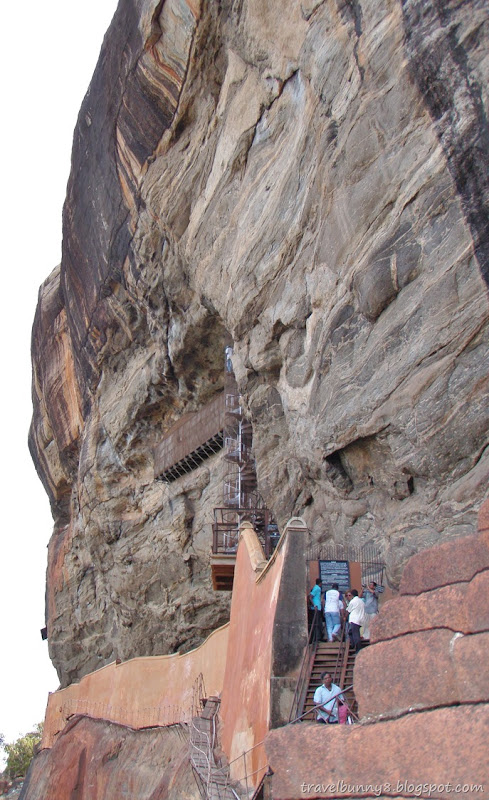 King Kashyapa I acquired the throne by overthrowing his father, King Dhatusena in a palace coup and usurping his brother and rightful heir to the throne, Moggallana who fled to south India. Kashyapa imprisoned and later executed his father.
King Kashyapa I acquired the throne by overthrowing his father, King Dhatusena in a palace coup and usurping his brother and rightful heir to the throne, Moggallana who fled to south India. Kashyapa imprisoned and later executed his father. 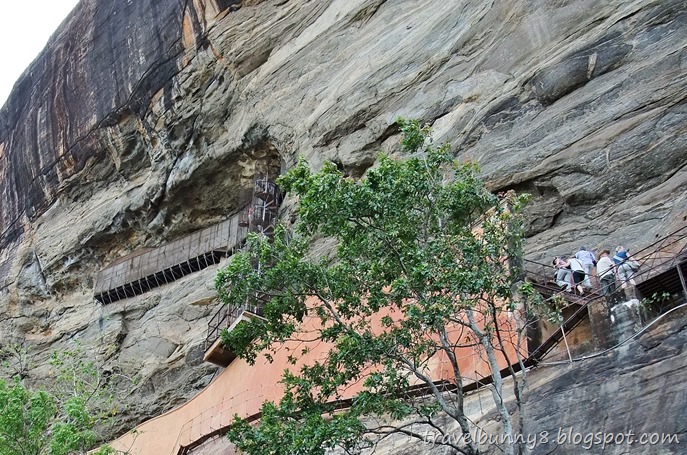 Fearing an attack by Moggallana, King Kashyapa I moved the capital and his residence from the traditional capital of Anuradhapura to the more secure location of Sigiriya.
Fearing an attack by Moggallana, King Kashyapa I moved the capital and his residence from the traditional capital of Anuradhapura to the more secure location of Sigiriya.  Before the construction of a fortress, Sigiriya was used as a rock shelter monastery from about the 3rd century BC.
Before the construction of a fortress, Sigiriya was used as a rock shelter monastery from about the 3rd century BC.  The guide walking with me all the way to the top while telling me the history of Sigiriya.
The guide walking with me all the way to the top while telling me the history of Sigiriya.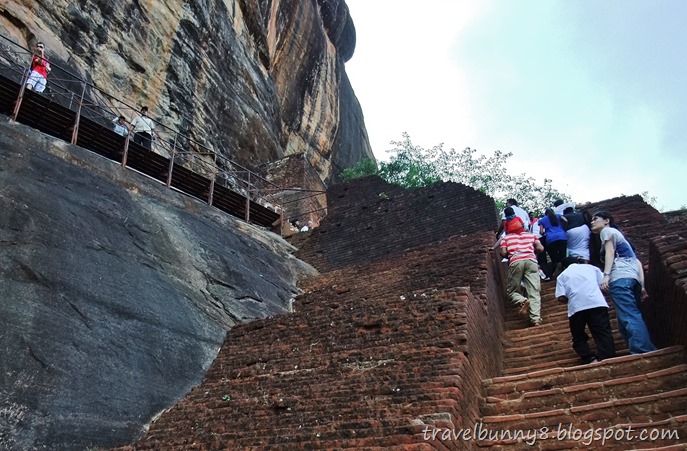 Huh? Not even half way there?
Huh? Not even half way there? 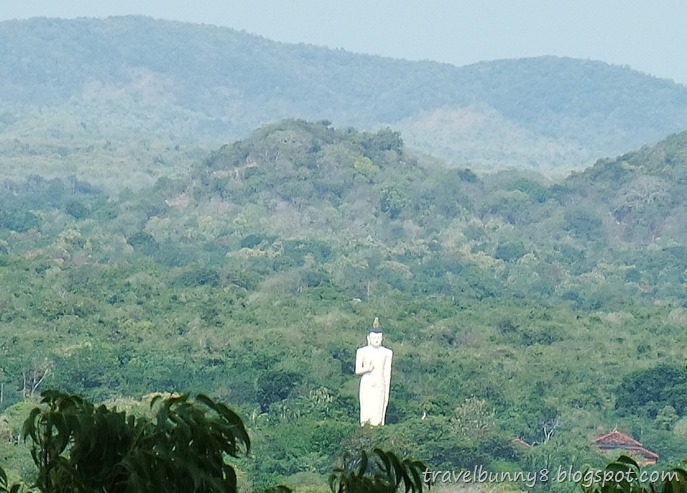 A giant Buddha statue emerging from the jungle in a distance.
A giant Buddha statue emerging from the jungle in a distance.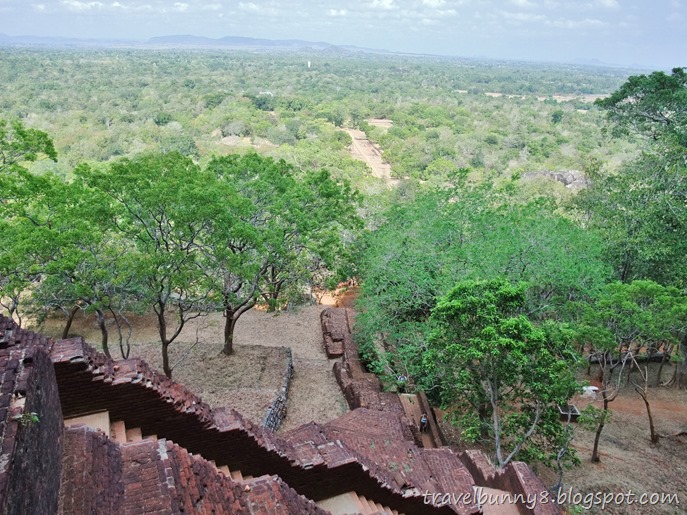 Can you see the white spot? That’s the giant Buddha statue I was mentioning.
Can you see the white spot? That’s the giant Buddha statue I was mentioning. 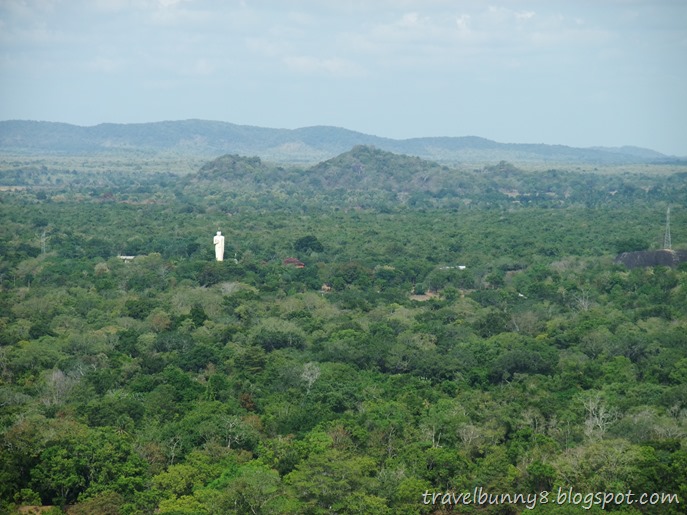 Really had a commanding view of the surroundings.
Really had a commanding view of the surroundings.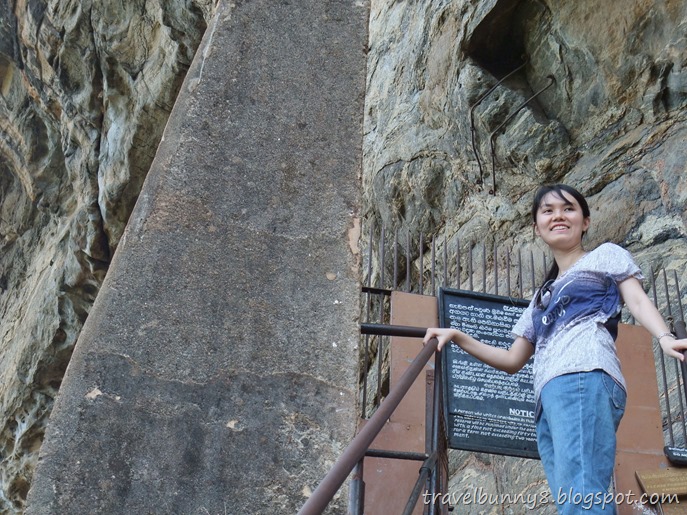 I am now halfway up the Sigiriya rock.
I am now halfway up the Sigiriya rock.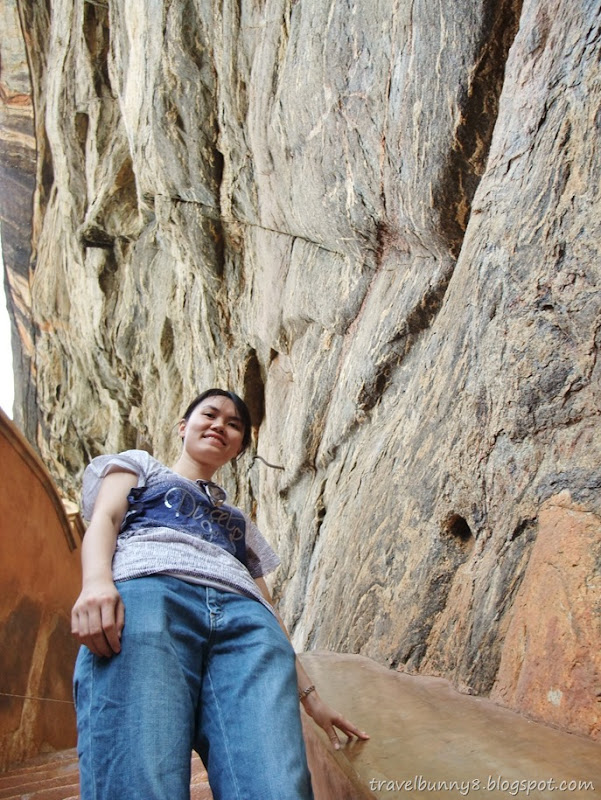
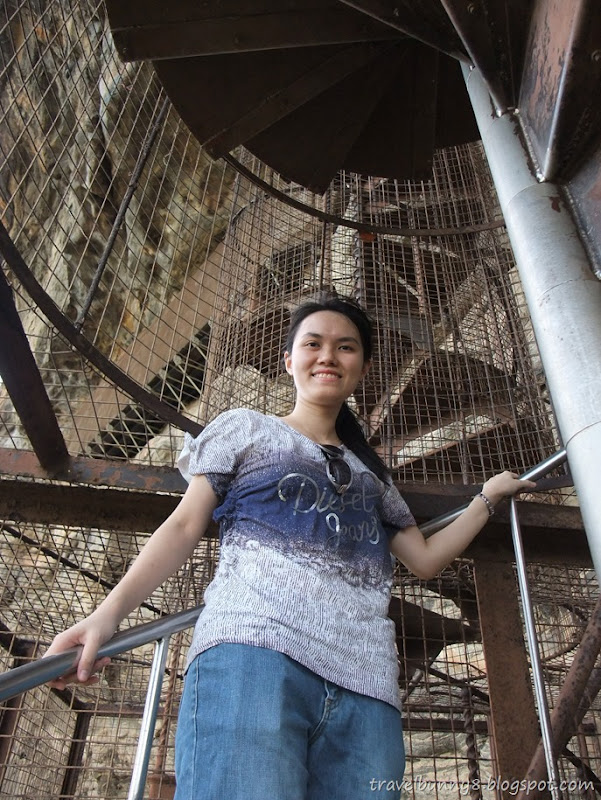 Going up the spiral staircase……
Going up the spiral staircase……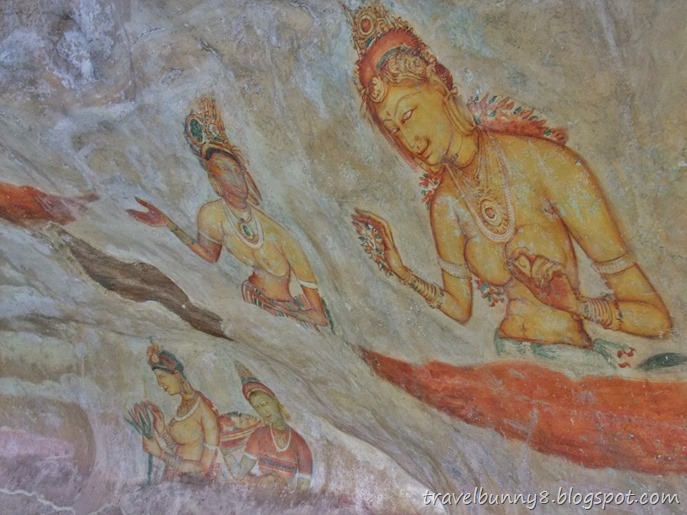 …….to see the 1,500 year old fresco popularly known as the ‘Sigiri Aspara’ or Sigiri Damsels.
…….to see the 1,500 year old fresco popularly known as the ‘Sigiri Aspara’ or Sigiri Damsels. 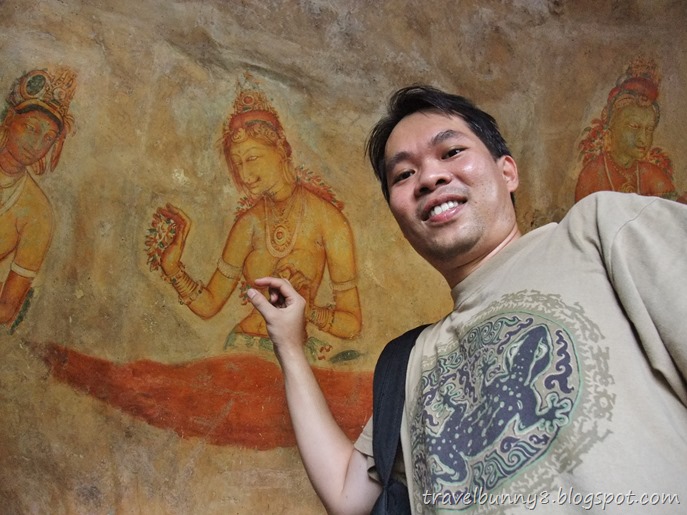 There are a total of 500 ladies in the painting believed to be of King Kashyapa’s concubines. He’s one lucky man or should I say unlucky?
There are a total of 500 ladies in the painting believed to be of King Kashyapa’s concubines. He’s one lucky man or should I say unlucky?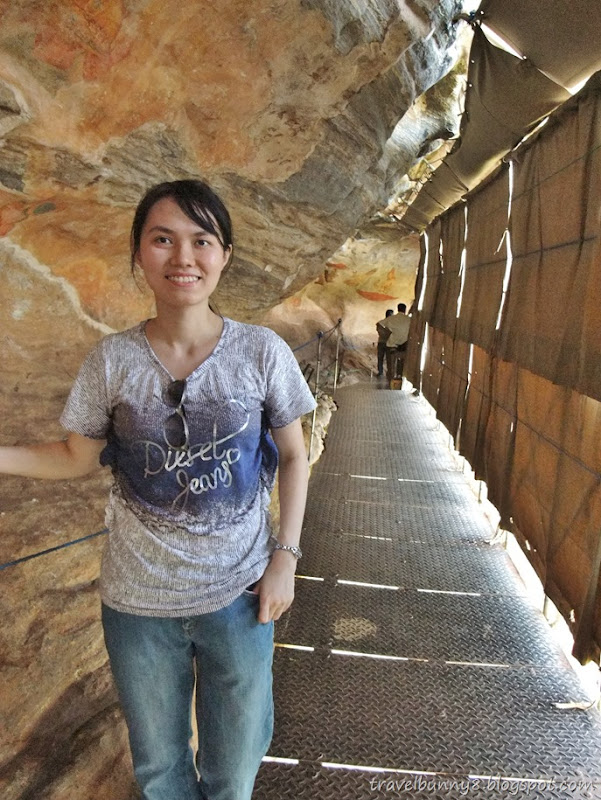 In year 1907, John Still suggested ‘The whole face of the hill appears to have been a gigantic picture gallery….the largest picture in the world perhaps’.
In year 1907, John Still suggested ‘The whole face of the hill appears to have been a gigantic picture gallery….the largest picture in the world perhaps’.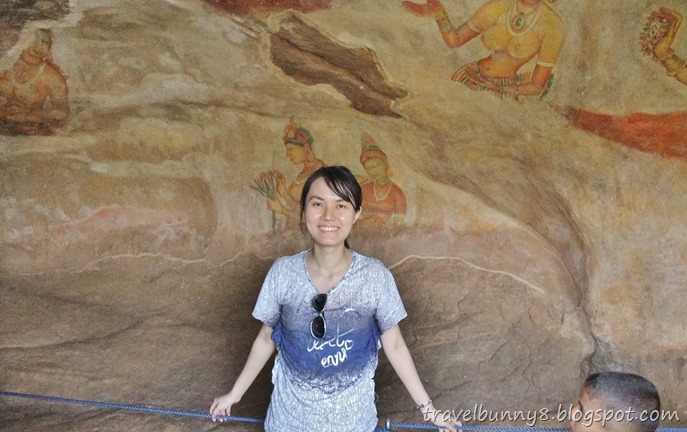 There are a total of 21 paintings here and after so many years the colour and details remains amazing. Most of the fresco are bare breasted maidens, so if you have kids with you or are offended by semi nude graphics, you can skip this part of the rock.
There are a total of 21 paintings here and after so many years the colour and details remains amazing. Most of the fresco are bare breasted maidens, so if you have kids with you or are offended by semi nude graphics, you can skip this part of the rock. 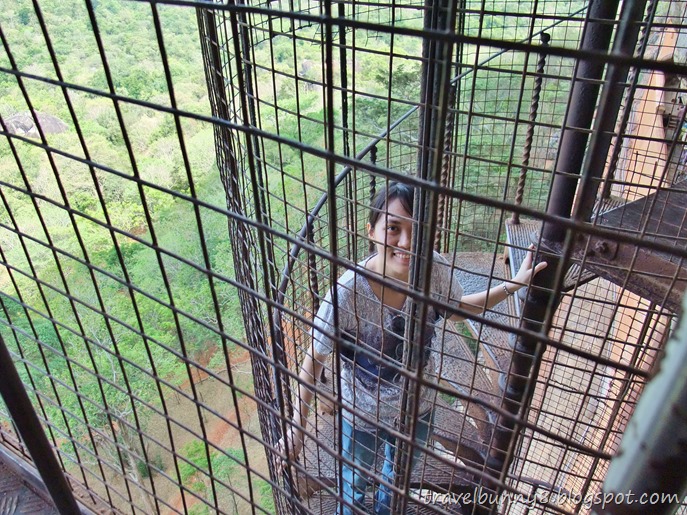 After viewing the Frescoes, you go back down the spiral staircase.
After viewing the Frescoes, you go back down the spiral staircase.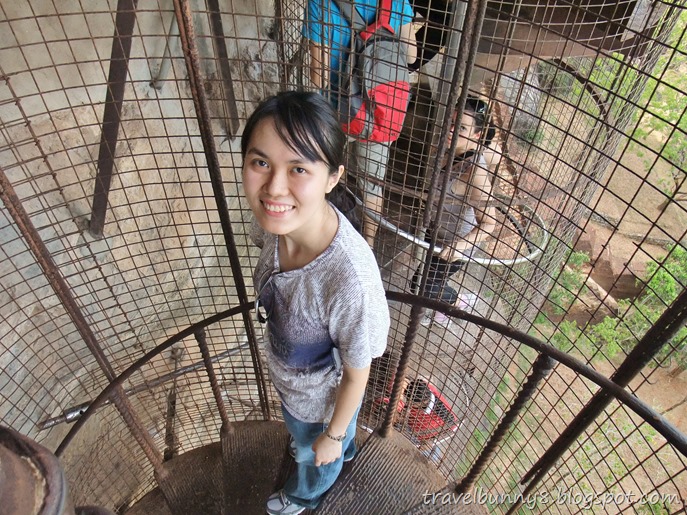 For those who are not interested in the frescos you don’t need to climb the spiral staircase.
For those who are not interested in the frescos you don’t need to climb the spiral staircase.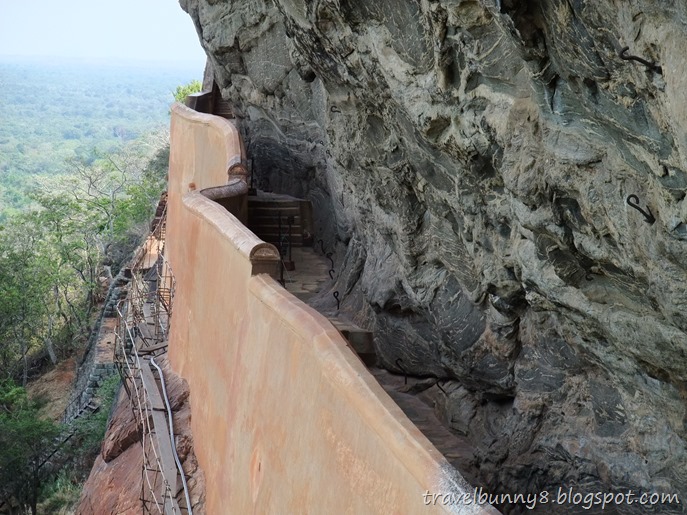 Just head straight to the Kedapath Pavura or better known as the Sigiriya Mirror Wall.
Just head straight to the Kedapath Pavura or better known as the Sigiriya Mirror Wall. Known as the Mirror Wall because its surface used to be highly polished like a mirror.
Known as the Mirror Wall because its surface used to be highly polished like a mirror.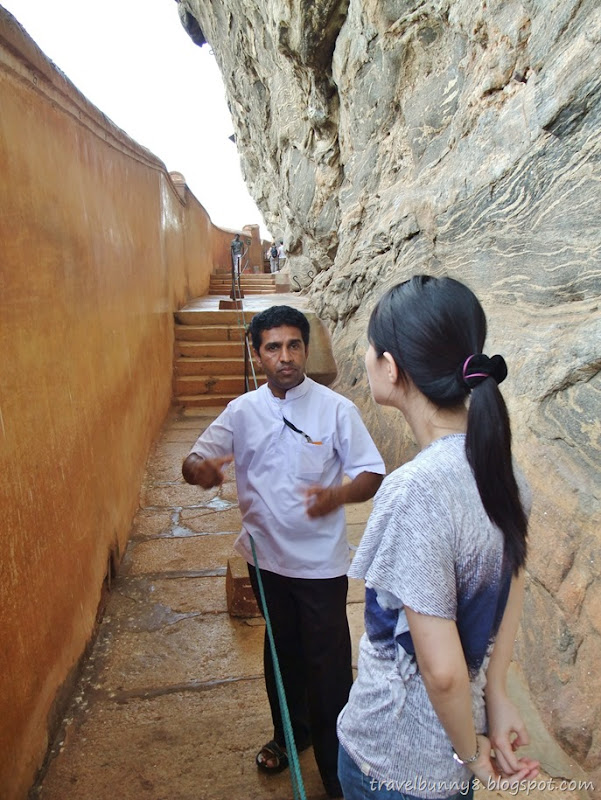 The guide explaining that the 3m high wall is made of porcelain and was so polished that the king could see his image on it as he walked alongside it.
The guide explaining that the 3m high wall is made of porcelain and was so polished that the king could see his image on it as he walked alongside it. 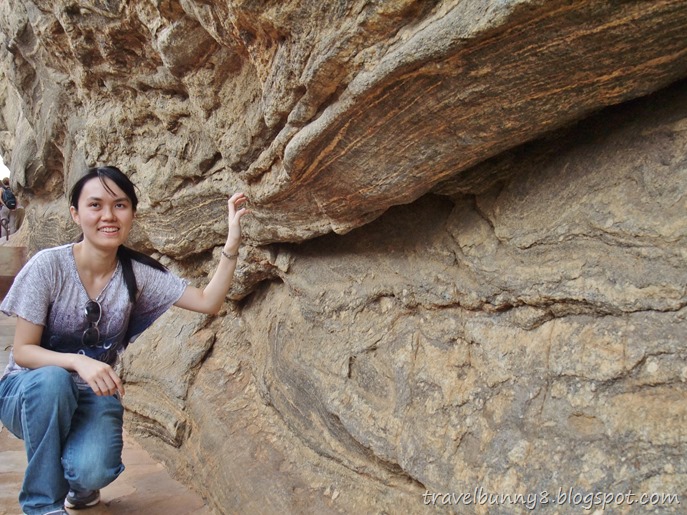

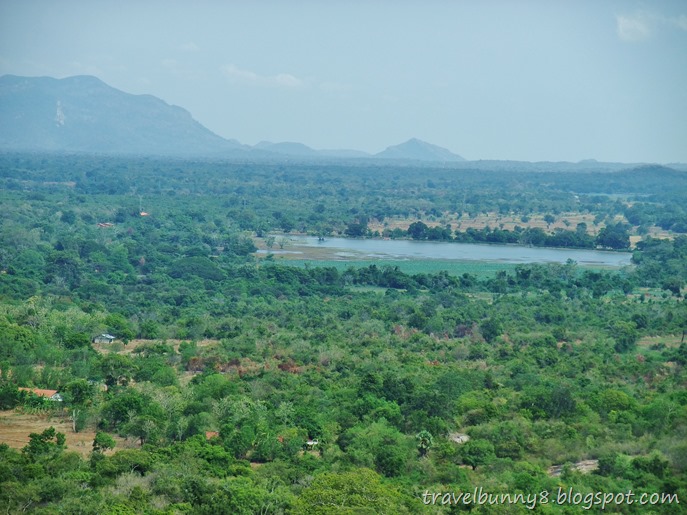 Bird's eye view on the surrounding area.
Bird's eye view on the surrounding area.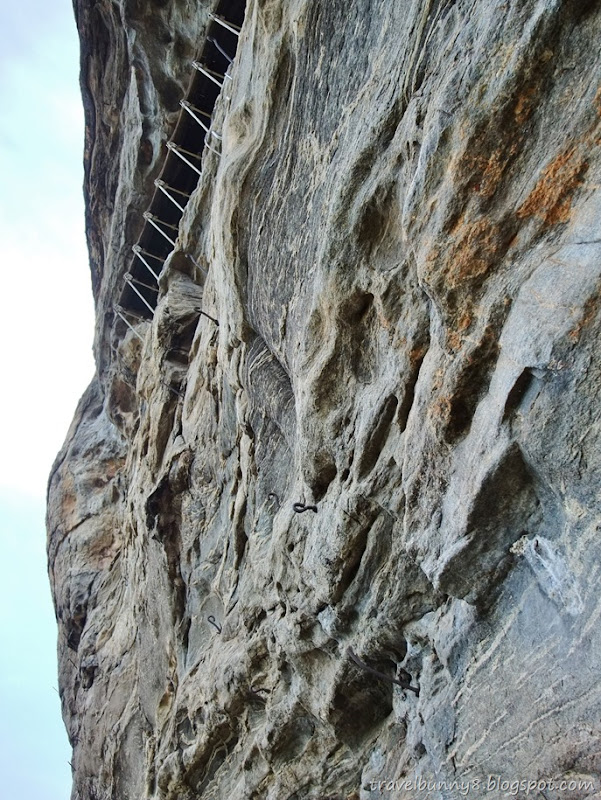 The iron stairway and platform sure does look scary.
The iron stairway and platform sure does look scary.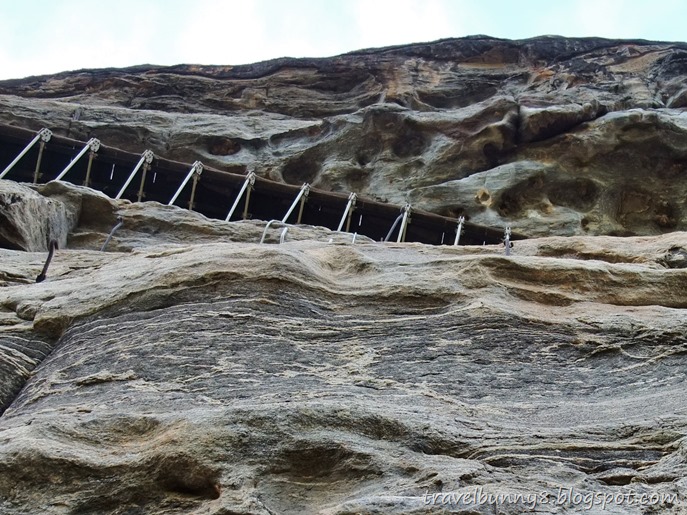 You shouldn't worry as the platform and stairs are securely anchored to the rock surface.
You shouldn't worry as the platform and stairs are securely anchored to the rock surface. 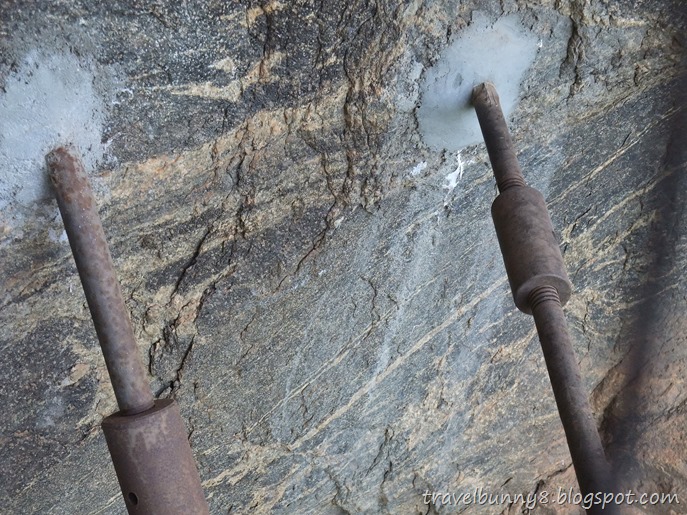 So far nobody has ever fallen off the Sigiriya rock.
So far nobody has ever fallen off the Sigiriya rock. 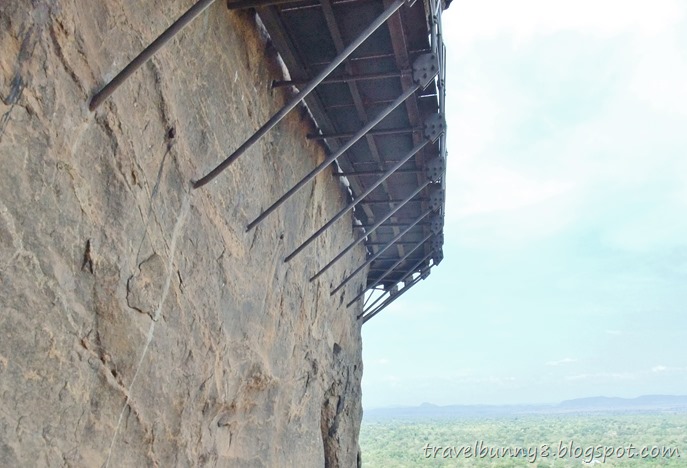 If the structure really fails, it would be more than a 100 meter free fall.
If the structure really fails, it would be more than a 100 meter free fall. 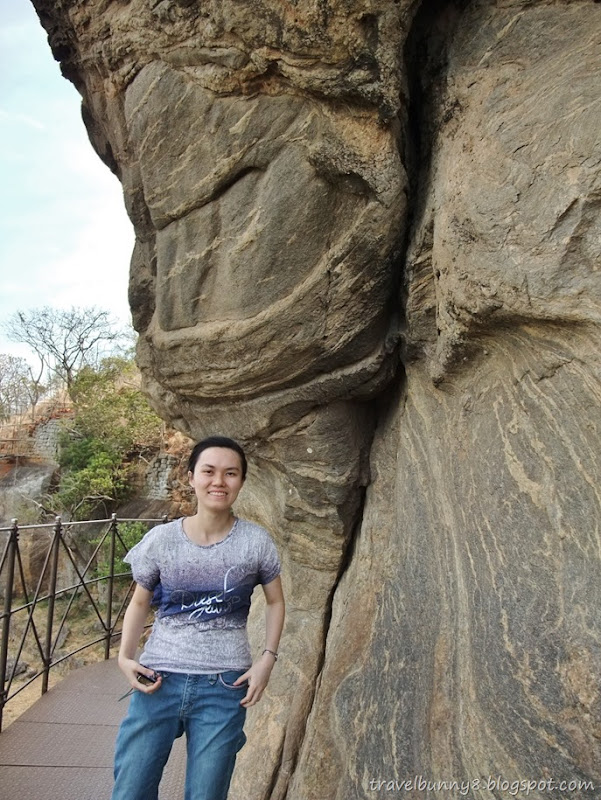 It’s actually very windy up the rock.
It’s actually very windy up the rock.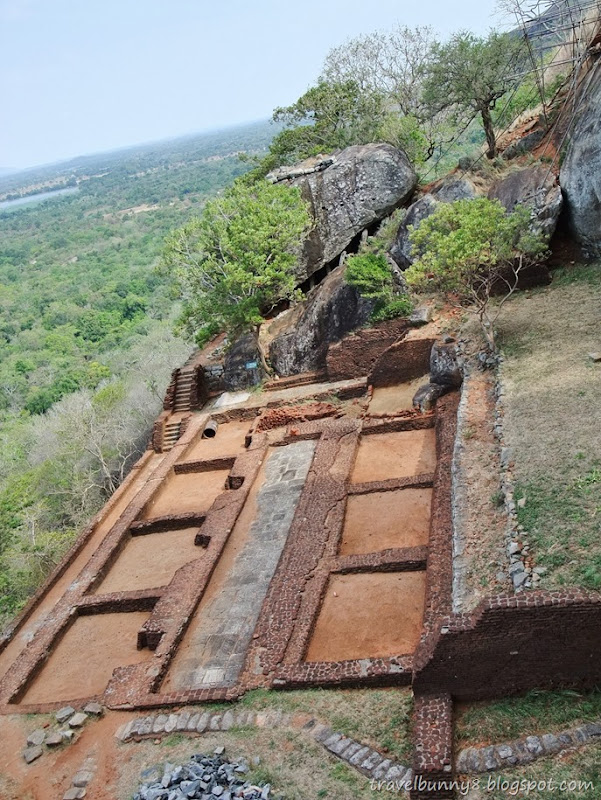 One of the defence mechanism of the rock.
One of the defence mechanism of the rock.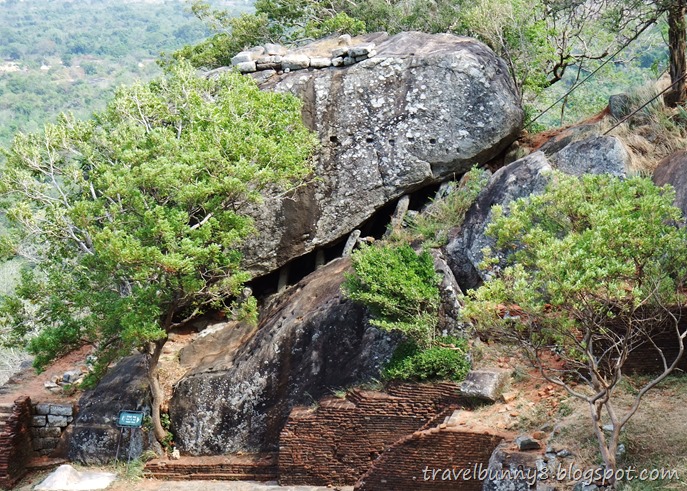 If enemies are spotted, the huge boulder will be released.
If enemies are spotted, the huge boulder will be released.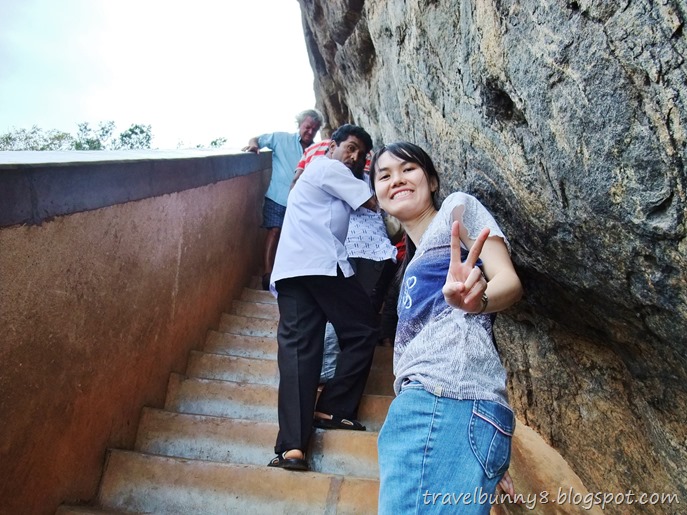
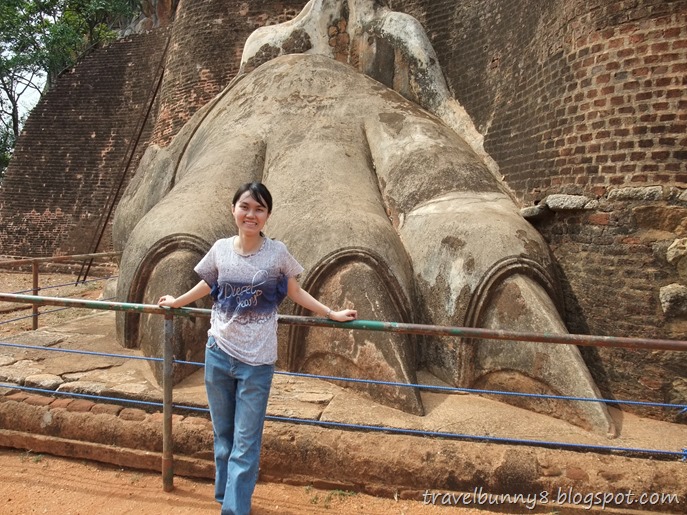 Huge, stone sculptured claws flank the walled temple stairway.
Huge, stone sculptured claws flank the walled temple stairway. 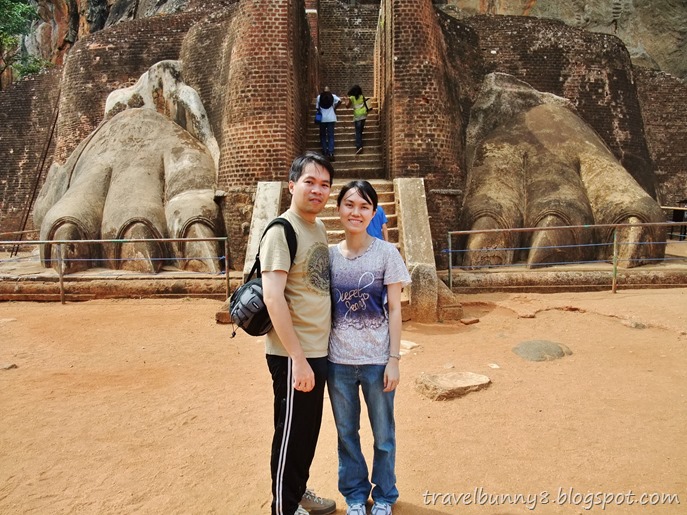 This is the entrance to the upper palace. the fortress was built in a form of a crouching lion and the entrance to the enormous fort was once through the lion’s mouth. However, the gigantic paws are the only remaining features of the lion today.
This is the entrance to the upper palace. the fortress was built in a form of a crouching lion and the entrance to the enormous fort was once through the lion’s mouth. However, the gigantic paws are the only remaining features of the lion today. 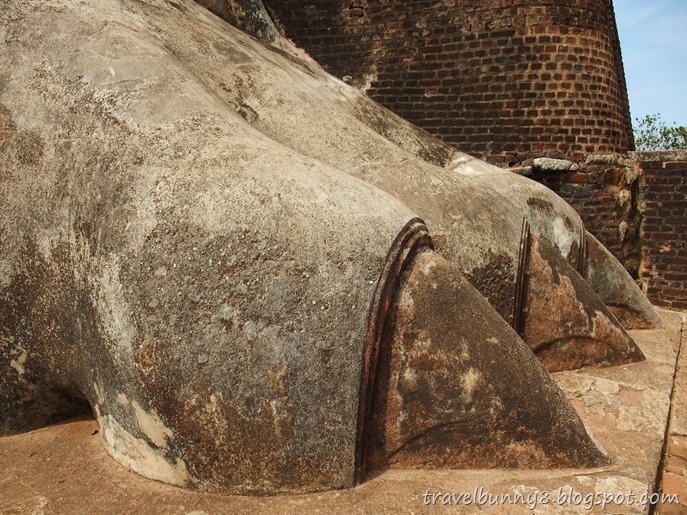
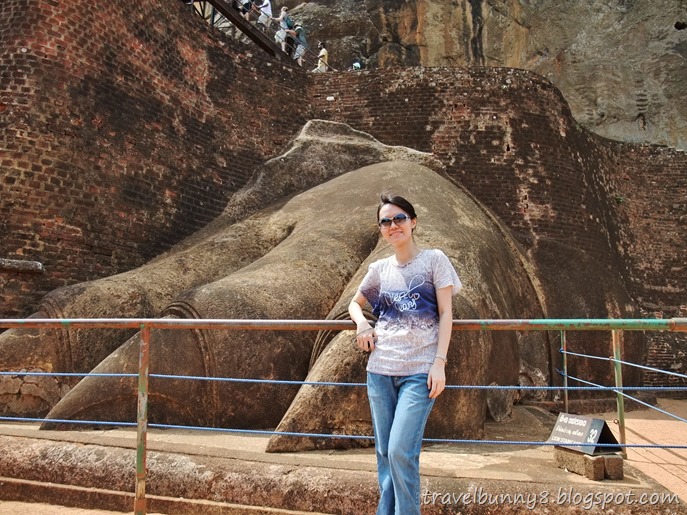 I can only imagine how gigantic the the rest of carvings must have been.
I can only imagine how gigantic the the rest of carvings must have been.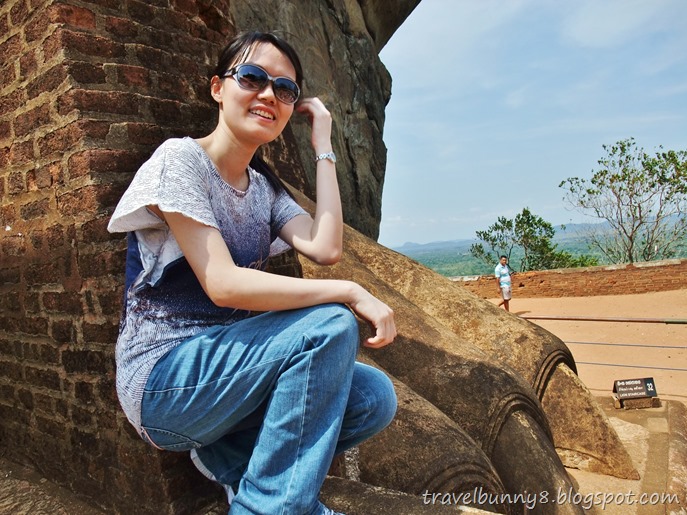
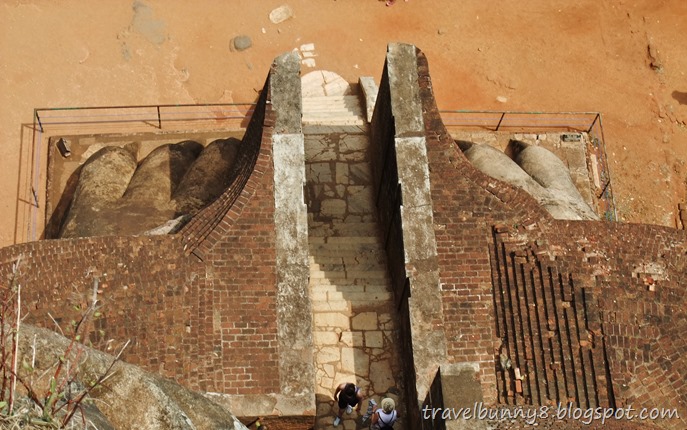 View of the lion’s claws from above.
View of the lion’s claws from above.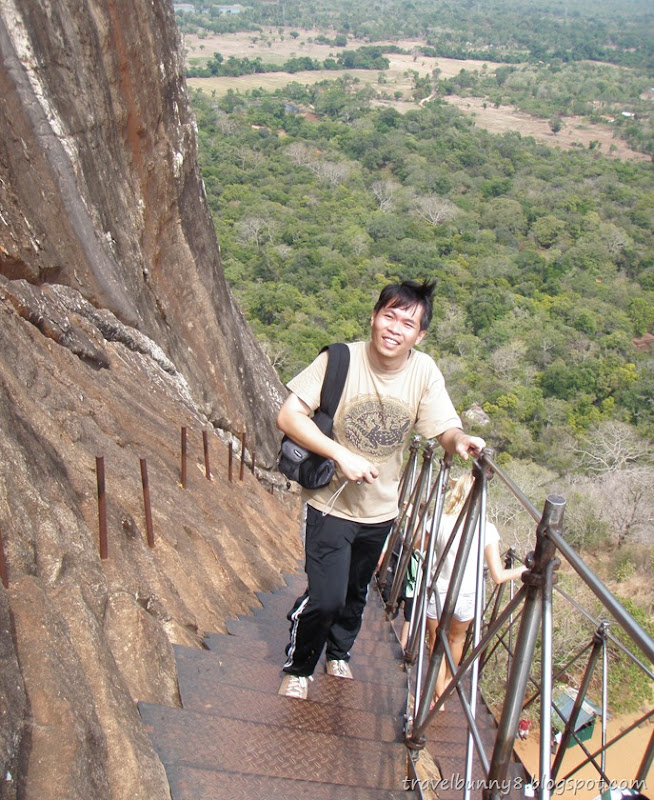 The steel staircase is narrow and steep and don’t stop here to catch your breath as there are likely to be people behind you waiting to go up.
The steel staircase is narrow and steep and don’t stop here to catch your breath as there are likely to be people behind you waiting to go up. 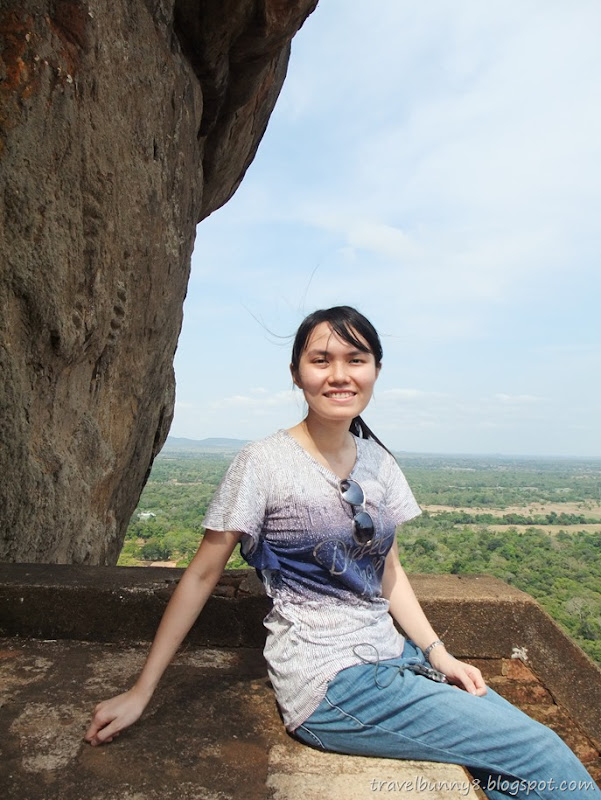 There are places for you to rest while enjoying the breeze and beautiful scenery.
There are places for you to rest while enjoying the breeze and beautiful scenery. 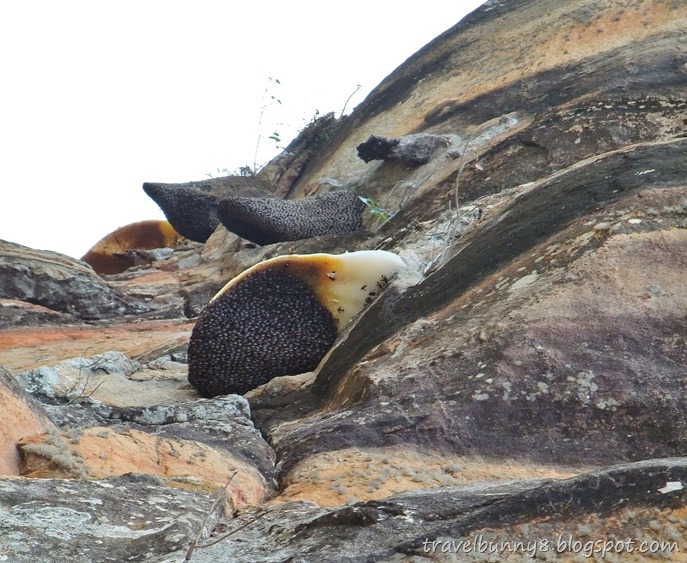 I was wondering what are those black lumps on the rock until I saw it moving. They are actually bee hives. The giant honey bee is the most aggressive bee in South Asia and locals believe the bees to be reincarnated soldiers of King Kashyapa protecting the rock from harm.
I was wondering what are those black lumps on the rock until I saw it moving. They are actually bee hives. The giant honey bee is the most aggressive bee in South Asia and locals believe the bees to be reincarnated soldiers of King Kashyapa protecting the rock from harm.Every few years, these bees go on a rampage and attack anything they see as threat. The worst attack was in 2004 when 200 visitors were stung resulting in some being hospitalised. Luckily, nothing untoward happened that day.
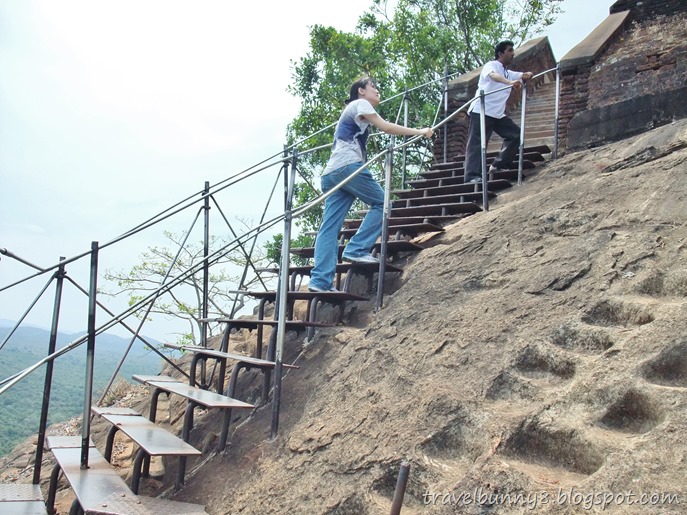 Indents in the rock where people used it as a stairway.
Indents in the rock where people used it as a stairway.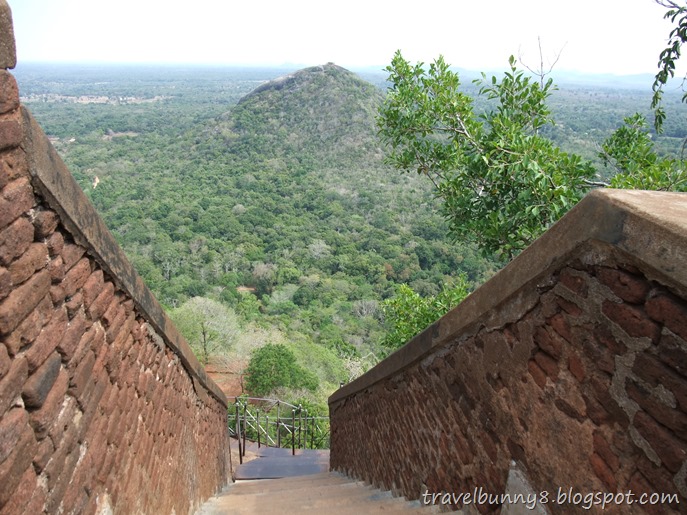 Final few steps heading up to the palace.
Final few steps heading up to the palace.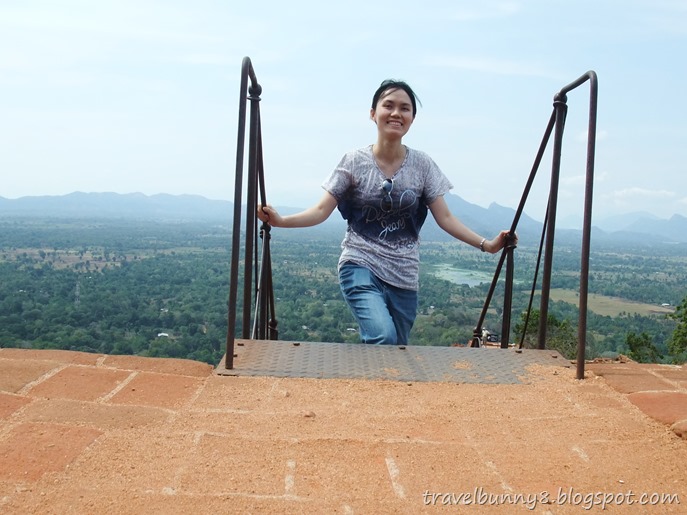 At last, I have arrived at the summit of the rock.
At last, I have arrived at the summit of the rock.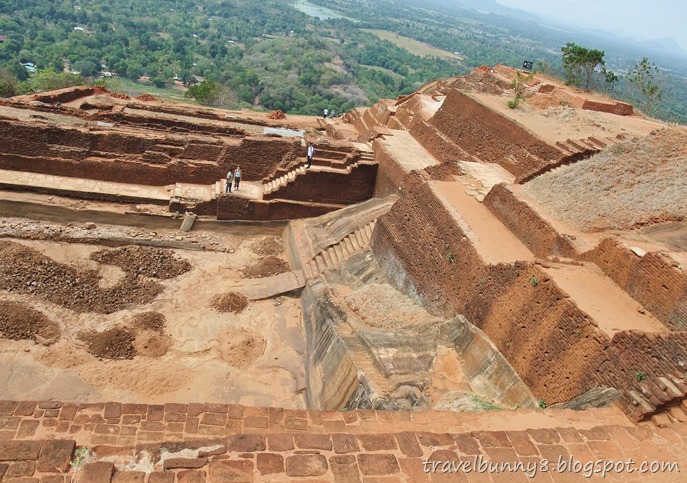 The remaining stairs and walls are still visible
The remaining stairs and walls are still visible 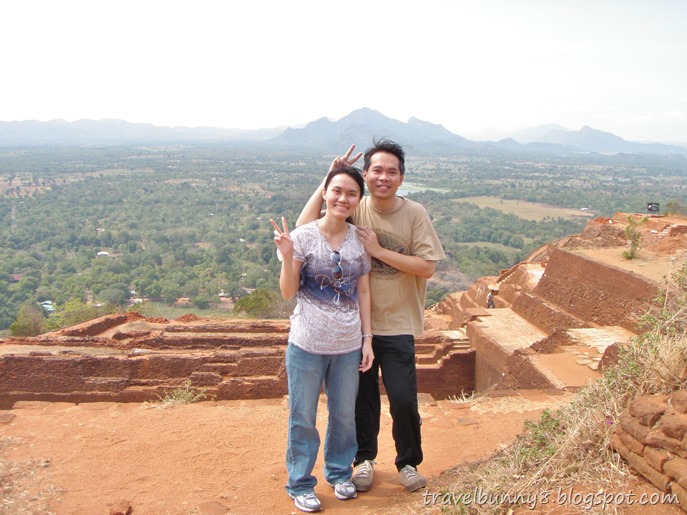 Most of the structures have been destroyed after a period of more than 1,500 years ago, but you can still tell it would have been a beautiful palace.
Most of the structures have been destroyed after a period of more than 1,500 years ago, but you can still tell it would have been a beautiful palace.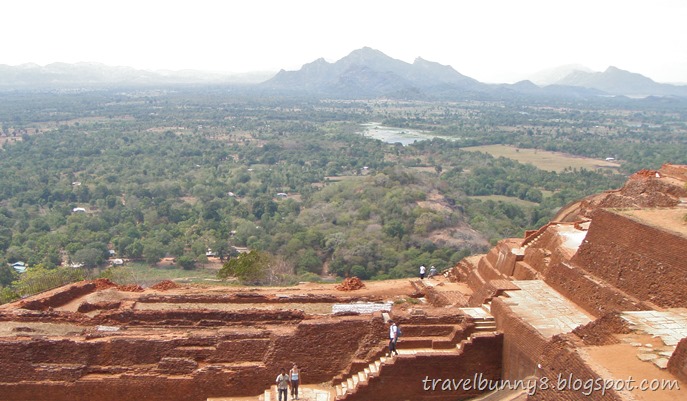 The stunning view from the top.
The stunning view from the top.
People of all ages whether young or old can make it to the top of Sigiriya. So don't worry too much about the climb. The view at the top will be worth your effort.
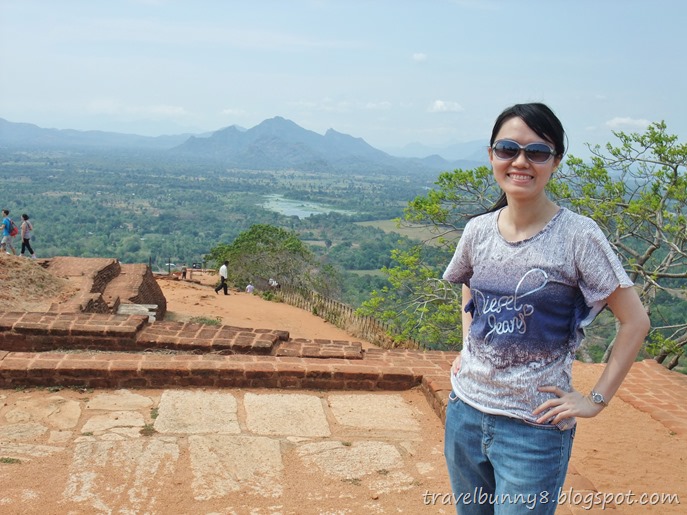 Land areas up to a distances of tens of kilometres can be seen making it hard for enemy to make a surprise attack on the kingdom.
Land areas up to a distances of tens of kilometres can be seen making it hard for enemy to make a surprise attack on the kingdom.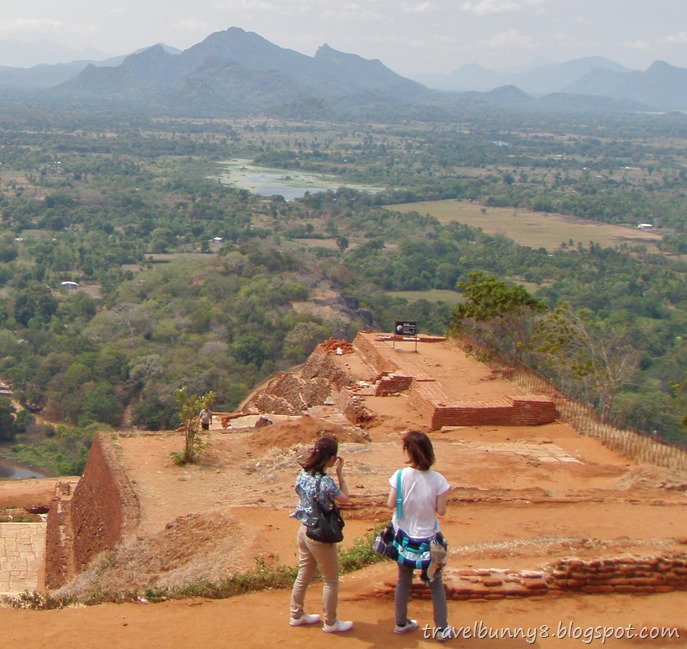 It is believed that the palace construction is constructed mainly out of timber, thus explaining why there isn't a structure left at the ruins except for the palace foundation.
It is believed that the palace construction is constructed mainly out of timber, thus explaining why there isn't a structure left at the ruins except for the palace foundation.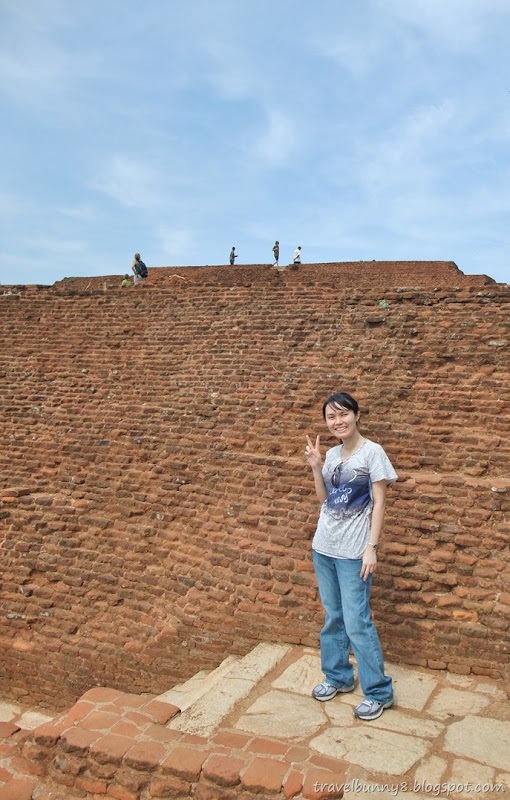 So how did they get water from so high up here? It is believed that water was brought up from a lake at the foot of the rock using ingenious hydraulic system powered by windmills.
So how did they get water from so high up here? It is believed that water was brought up from a lake at the foot of the rock using ingenious hydraulic system powered by windmills. 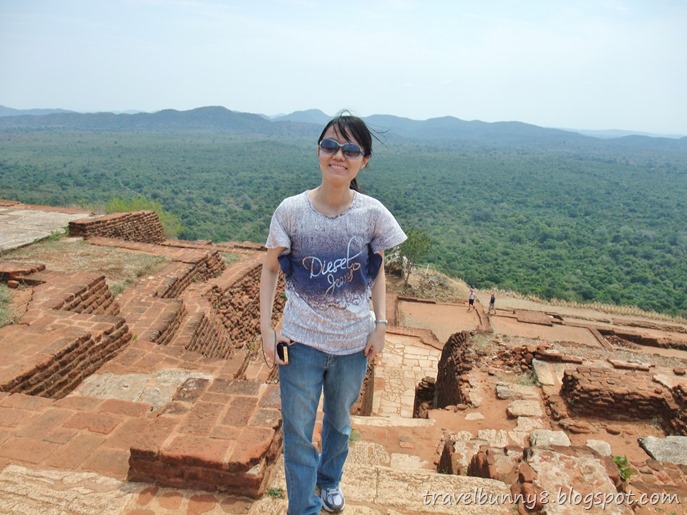 One can only imagine how beautiful it was when it was first built.
One can only imagine how beautiful it was when it was first built.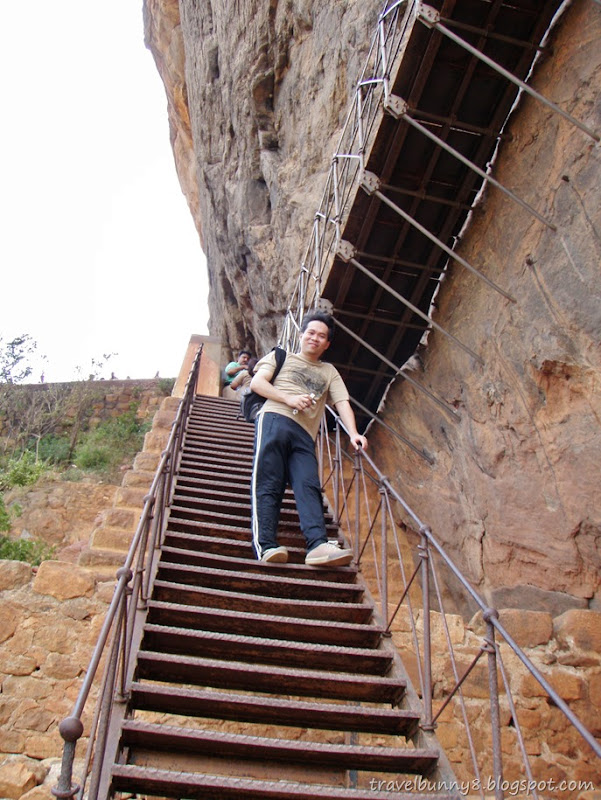 Time to descent the rock.
Time to descent the rock.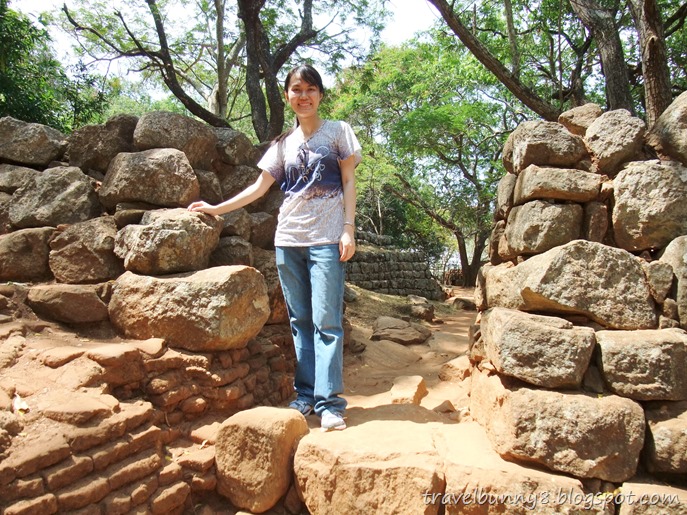 After 22 years reign by King Kashyapa I, he was defeated by Moggallana’s army in the year 495. While in battle, King Kashyapa who was mounted on a battle elephant changed course to take a strategic advantage, but his army misinterpreted the move as the King opted to retreat, prompting the army to abandon the king altogether. Being too proud to surrender, the king took out his dagger, cut his throat, raised the dagger proudly and fell dead.
After 22 years reign by King Kashyapa I, he was defeated by Moggallana’s army in the year 495. While in battle, King Kashyapa who was mounted on a battle elephant changed course to take a strategic advantage, but his army misinterpreted the move as the King opted to retreat, prompting the army to abandon the king altogether. Being too proud to surrender, the king took out his dagger, cut his throat, raised the dagger proudly and fell dead. 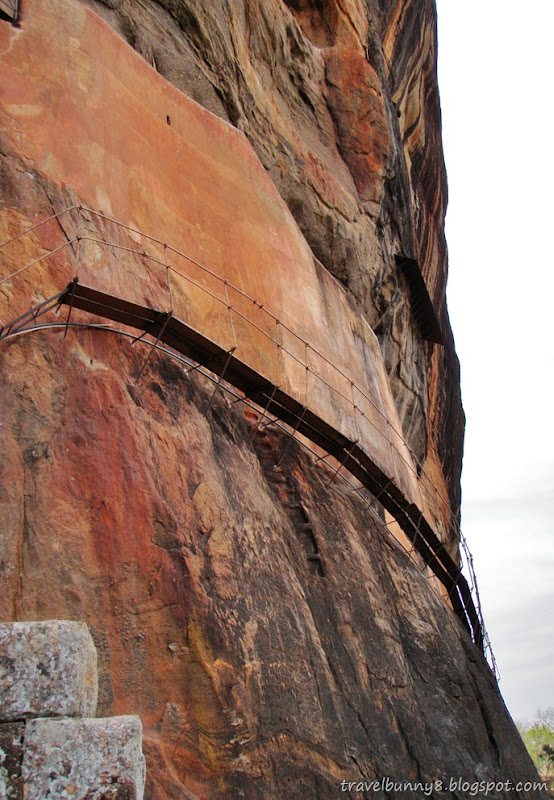 With such an impregnable fortress, was it really possible to defeat Kashyapa? Some say that the fortress was never really put to the test as he was assassinated by one of his concubines.
With such an impregnable fortress, was it really possible to defeat Kashyapa? Some say that the fortress was never really put to the test as he was assassinated by one of his concubines. 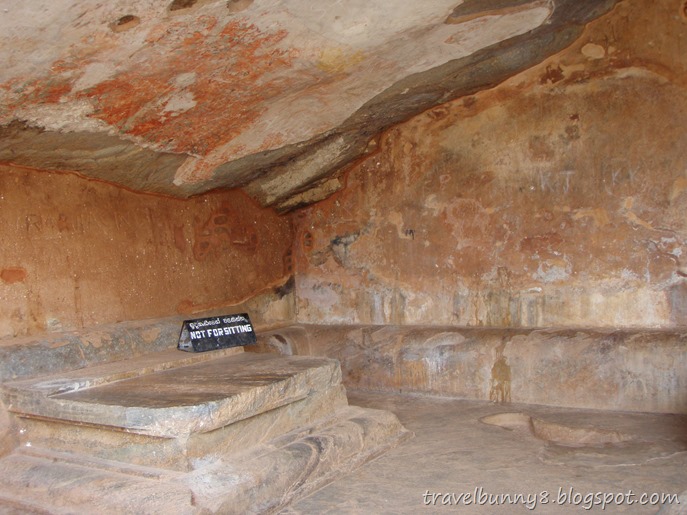 After the defeat of Kashyapa, Moggallana returned to the throne and moved the capital back to its original location in Anuradhapura. Sigiriya once again became a Buddhist monastery which lasted until about the 14th century after which it was abandoned.
After the defeat of Kashyapa, Moggallana returned to the throne and moved the capital back to its original location in Anuradhapura. Sigiriya once again became a Buddhist monastery which lasted until about the 14th century after which it was abandoned. 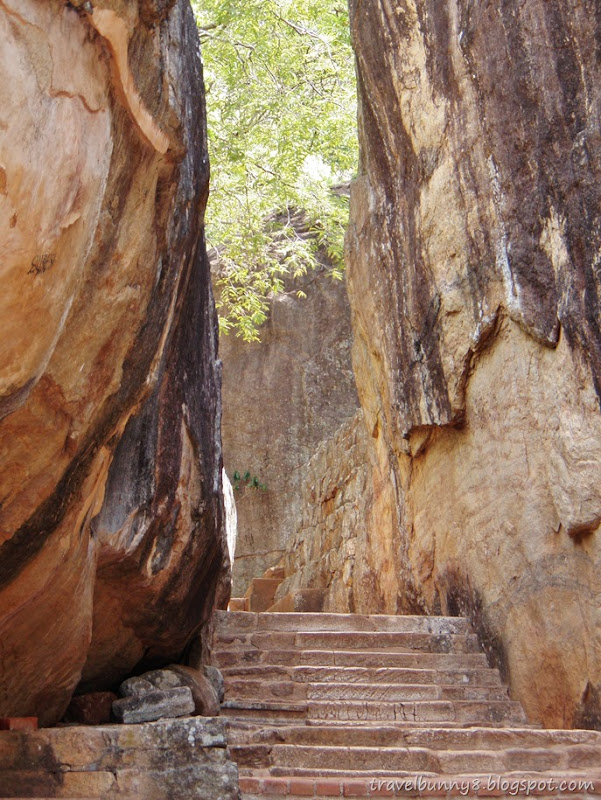 Forgotten for the next 7 centuries, Sigiriya was rediscovered by Major H. Forbes Still in 1831 during the rule of British.
Forgotten for the next 7 centuries, Sigiriya was rediscovered by Major H. Forbes Still in 1831 during the rule of British.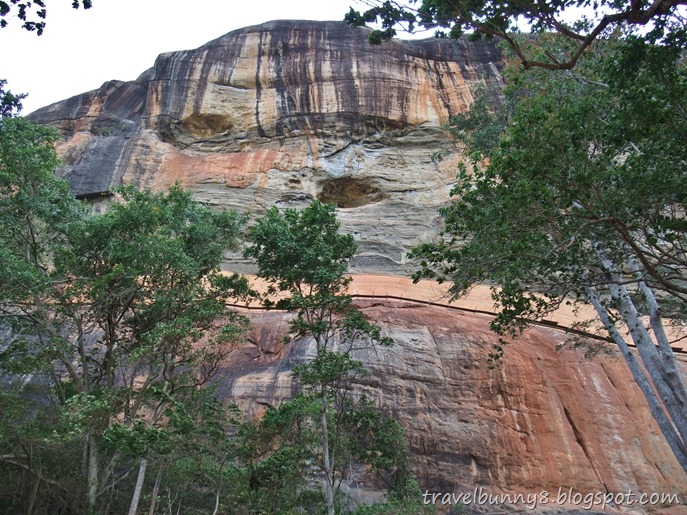 View of the Western rock face as I descent. The descent route is separated from the ascent.
View of the Western rock face as I descent. The descent route is separated from the ascent.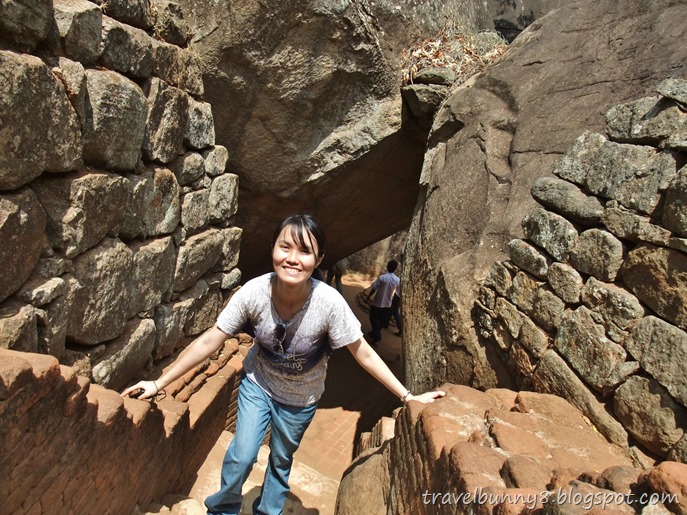 The whole trip took about 3.5 hours including the 2.5 hours for the ascent and descent of the rock. The climb might be long but it’s not challenging. Unless you’re afraid of heights, Sigiriya is definitely recommended while visiting Sri Lanka.
The whole trip took about 3.5 hours including the 2.5 hours for the ascent and descent of the rock. The climb might be long but it’s not challenging. Unless you’re afraid of heights, Sigiriya is definitely recommended while visiting Sri Lanka. 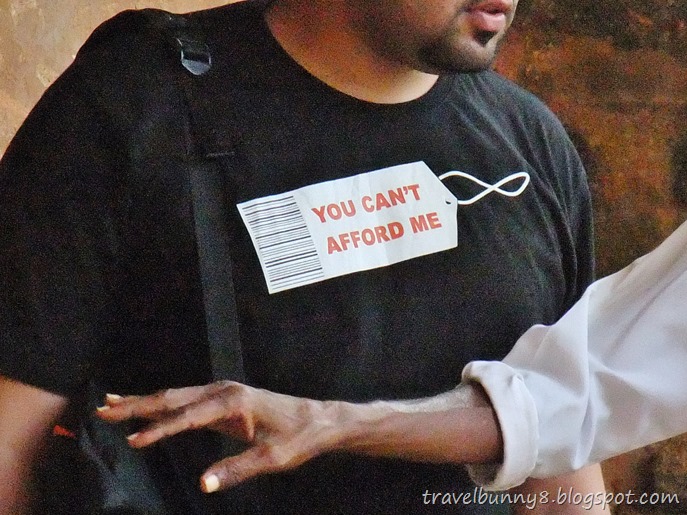 You can’t afford me.
You can’t afford me.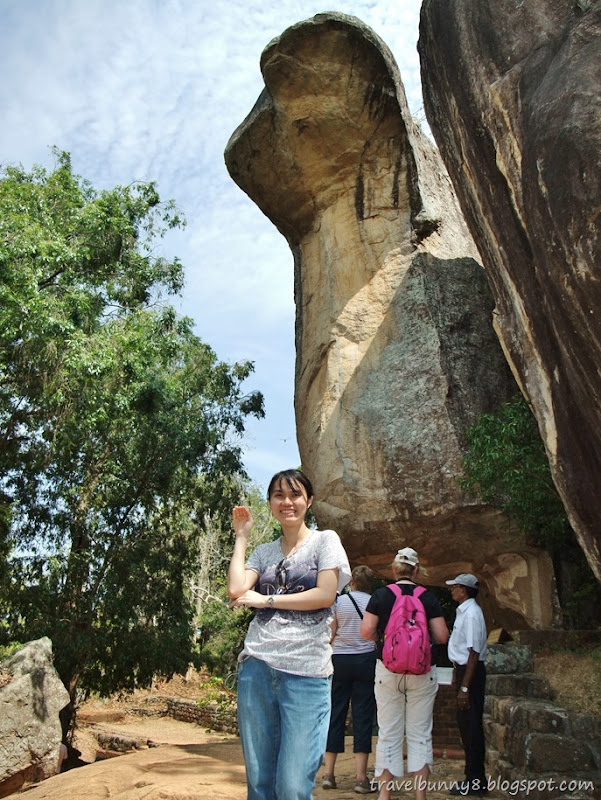 Known as the Cobra Head Cave because of the natural shape of the rock itself.
Known as the Cobra Head Cave because of the natural shape of the rock itself. 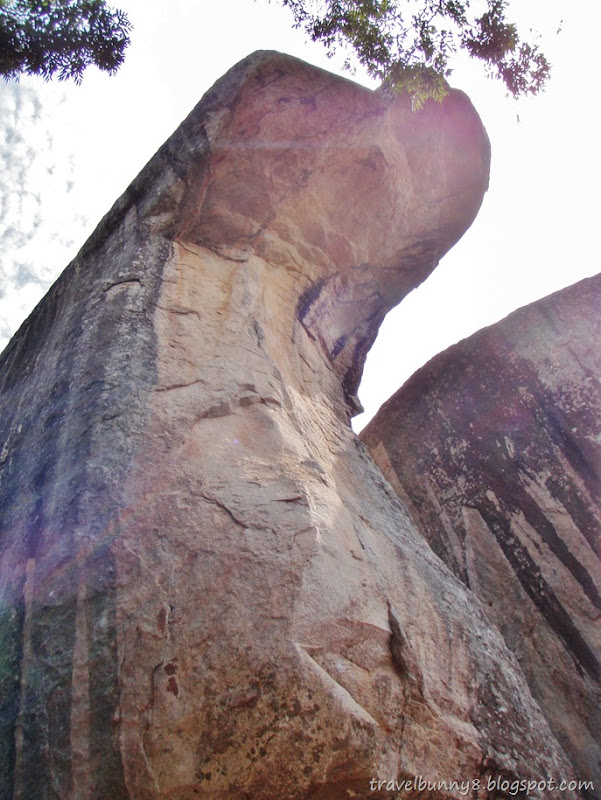 Used to be a dwelling place for the monks.
Used to be a dwelling place for the monks. 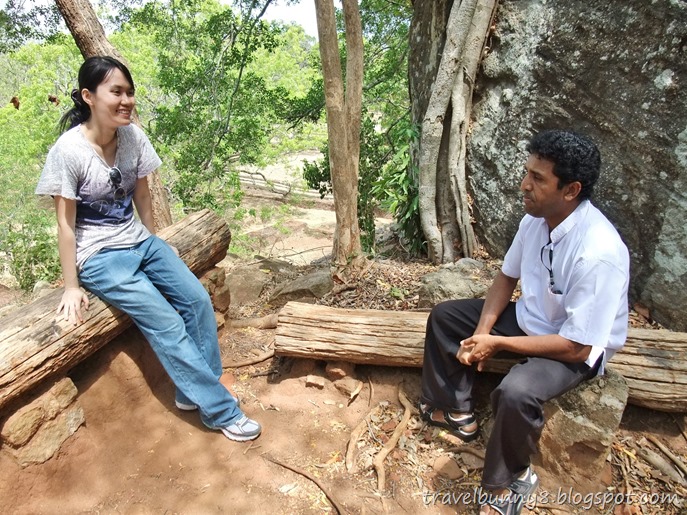 The Sigiriya guide summarizing the tour and of course negotiating for payment. I gave him USD 15, bid farewell and we’re on our way.
The Sigiriya guide summarizing the tour and of course negotiating for payment. I gave him USD 15, bid farewell and we’re on our way.  Sigiriya glorious days ended with Kashyapa’s death, but the grandeur of this rock lives on.
Sigiriya glorious days ended with Kashyapa’s death, but the grandeur of this rock lives on. 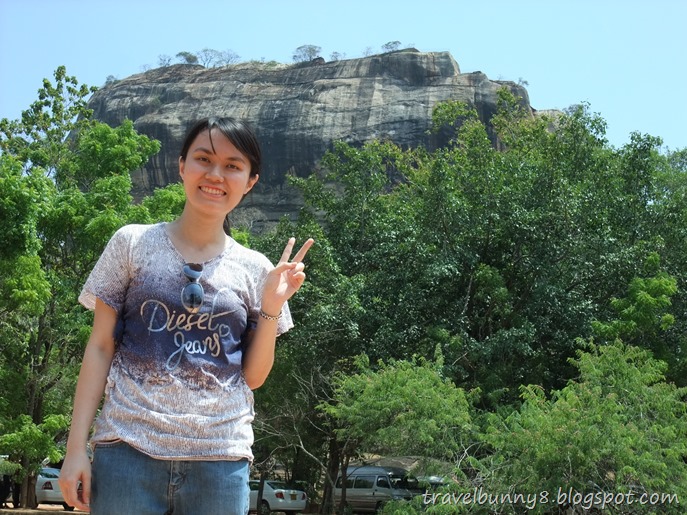 One last picture of Sigiriya before leaving.
One last picture of Sigiriya before leaving.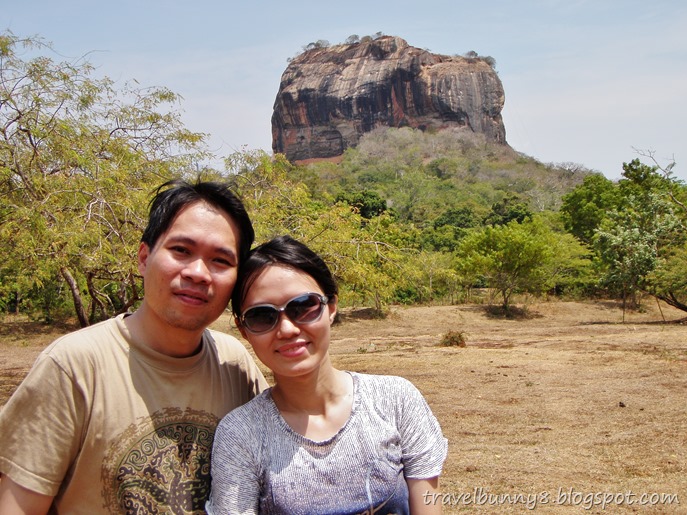 Well not really, the guide brought us to some strategic spot to take photographs of Sigiriya rock.
Well not really, the guide brought us to some strategic spot to take photographs of Sigiriya rock. 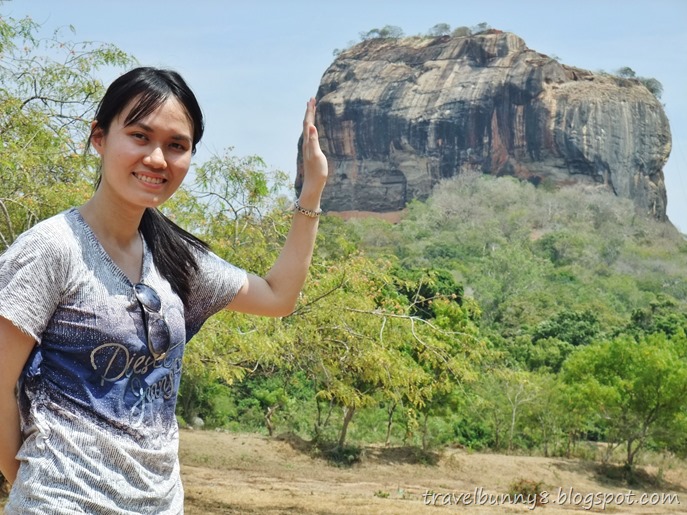
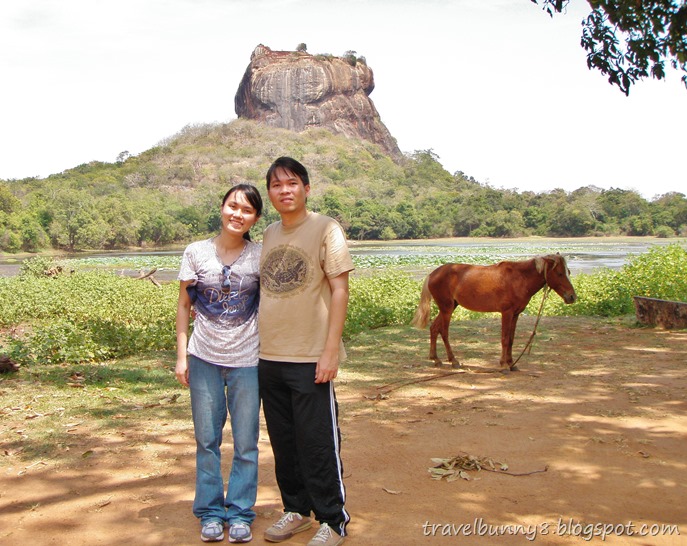
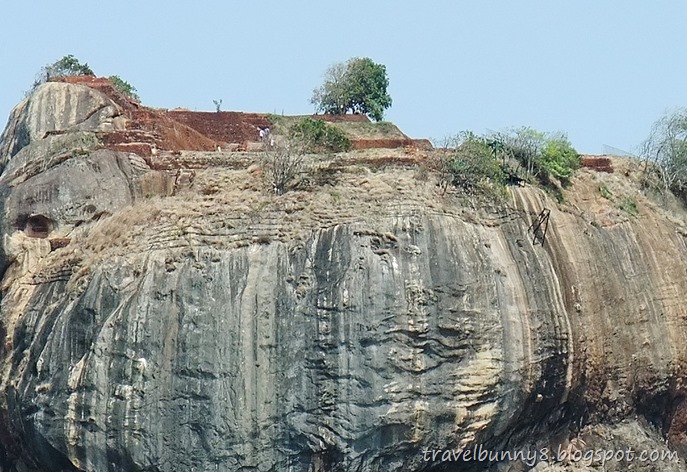 The ruins of the palace at the top of the rock is visible from this side of the rock.
The ruins of the palace at the top of the rock is visible from this side of the rock. 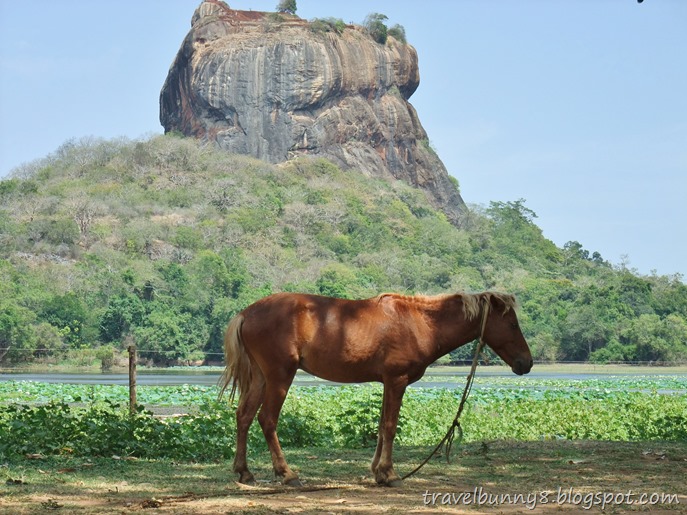
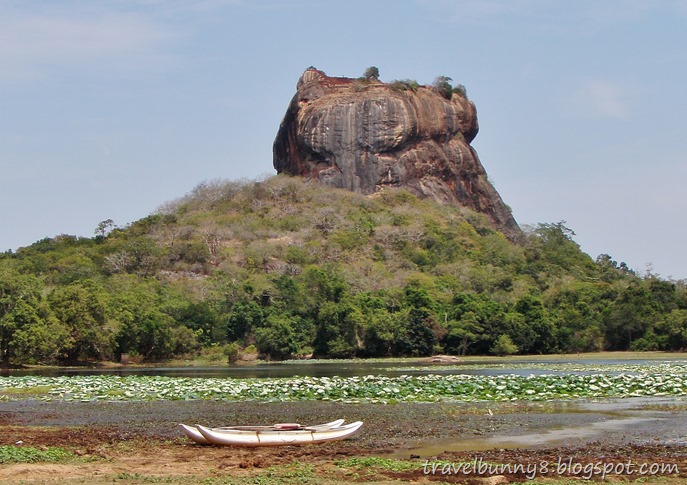 Sri Lanka has eight sites which have been inscribed in the UNESCO World Heritage Site. During my stay in Sri Lanka, I have been to six of them. My next posting shall be the third World Heritage Site, stay tuned.
Sri Lanka has eight sites which have been inscribed in the UNESCO World Heritage Site. During my stay in Sri Lanka, I have been to six of them. My next posting shall be the third World Heritage Site, stay tuned.Previous<<




![[MALAYSIA] How To Do A Self Guided Walking Tour in Kota Kinabalu](https://blogger.googleusercontent.com/img/b/R29vZ2xl/AVvXsEgR_cJjX4Shl9rsz0ufzxjmtLMq5PAvmTNDHypSVV2CYDaarZVj8EMznRkXqdVeCGg2yEMdFqPtI5rvrmMtJVSL1W9jqOtdCM2EFAc5ZTWn7XzPQV5sqS4s1DO0T_AuF0nq_dLQ53b9-ju3yyLJUrvU2TlhbmD4rDDV5-aPFaT2WEQZ1c257JXGUhyfsw/s72-c/20220524_131141.jpg)
![[FRANCE] My Favourite Paris Eiffel Tower Photo Spots](https://blogger.googleusercontent.com/img/b/R29vZ2xl/AVvXsEi220KHLfBDpyO53KorHwAb0KQEuiiaVDlrFYwEEAvs8YvKb-Edmyt7Hl7rZszN6qc-GM4e3SmjBS2pUiCiv8ljl8mnrUR93Ljxb0xGrSZ4sZLPRErpbAj29btKvnIC67xV93iKnrH3QRcc/s72-w781-c-h505/DSCF4372.JPG)
![[MALAYSIA] Tips on Taking Instagrammable Photo at KL Street Art Lane (Map Included)](https://blogger.googleusercontent.com/img/b/R29vZ2xl/AVvXsEjsKxlD3eU8SJeOolcscKEZjU-YtCIpk-geUR_avDri9-hyDIjRPGfKrOq_Qcbmkkm-HpTTdbI7rTpFzFo3wzWi7R27qdiOEOhcDLvZb-6x52rgkw_hxI8WIYT6tb6eLbmBZAFyOTpLkQNy/s72-c/collage+cover.jpg)
![[MONACO] How To Visit Monaco In One Day From Nice](https://blogger.googleusercontent.com/img/b/R29vZ2xl/AVvXsEgZkJeVAOmz4LTRwY2uDTK131UJVUWH_44GUUU3H-ni63dK2BlNqITBIh5Tdcpz9kXTUb7ePW7f-PQ1Y7E6B4lnqKEHs_nL3Eop-ouoFhxayMI4lNCcUG-oJnGMVwpGDlBu8lfgn10H_QHw/s72-c/DSC06605.JPG)
![[FRANCE] My Unforgettable Trip to Mont Saint-Michel](https://blogger.googleusercontent.com/img/b/R29vZ2xl/AVvXsEiVPyy72HIGsb8lnH7zvmCT8fKDLby20OtHvFN2rAp_BWadwYBvOq3Ny-JtjTu1CTXP4rSHUxr7Z0yOgE7zFqDFwC2HEuCWp-F2ykSwXCFNeis4Q7a5IpyepHyfv9BXibLV2s8E-7mqMFx4/s72-c/DSC05363.JPG)
0 comments: